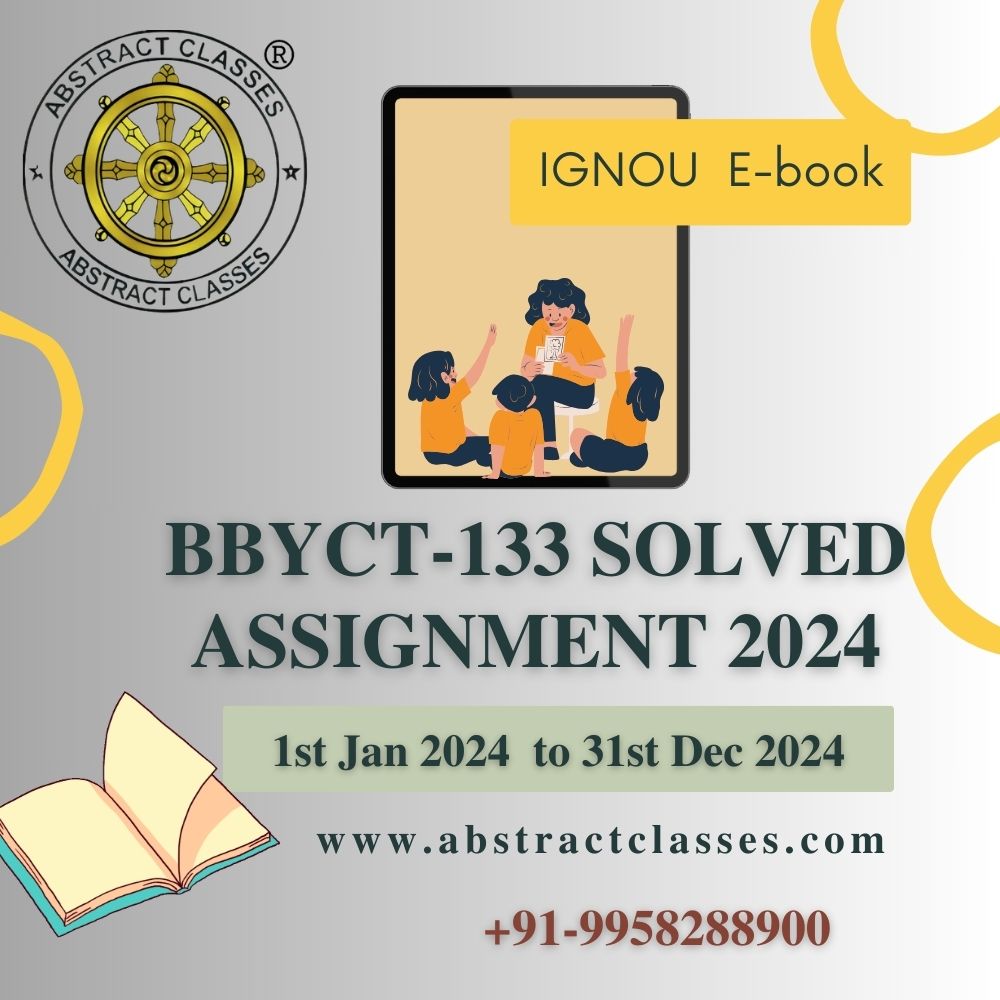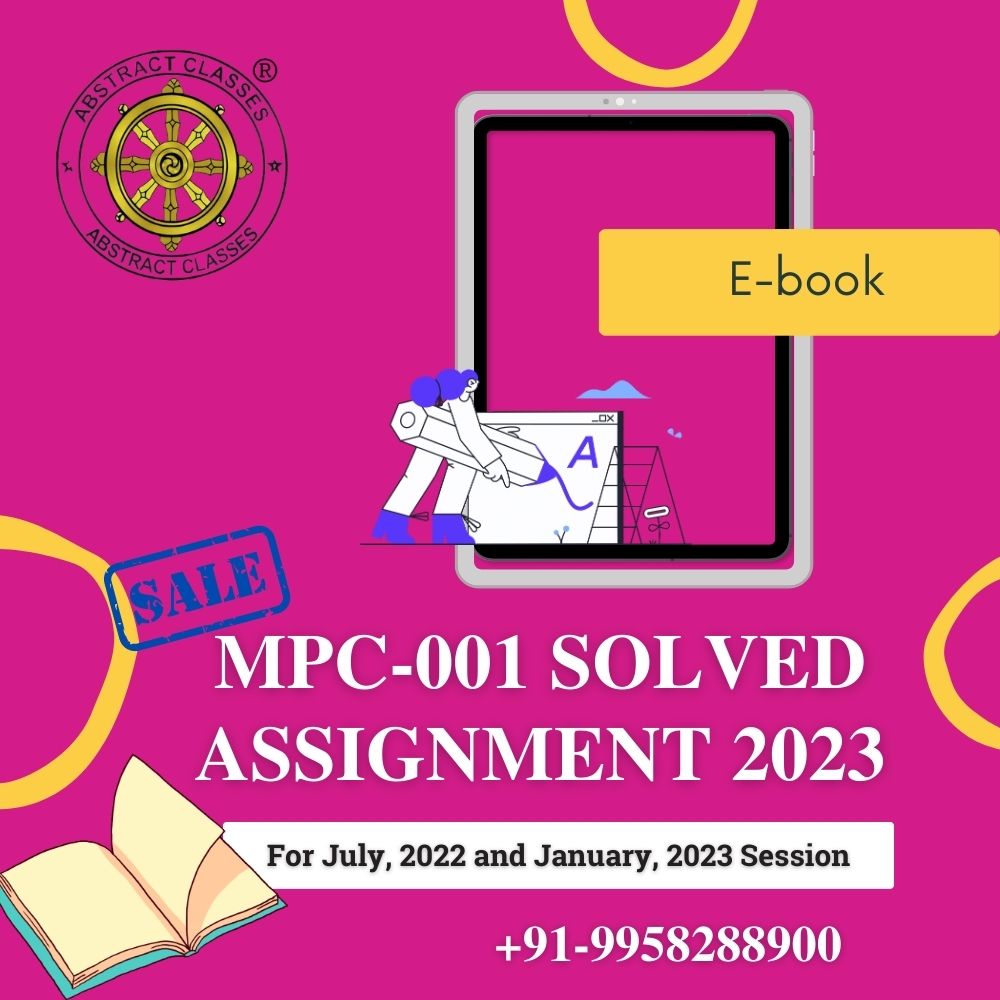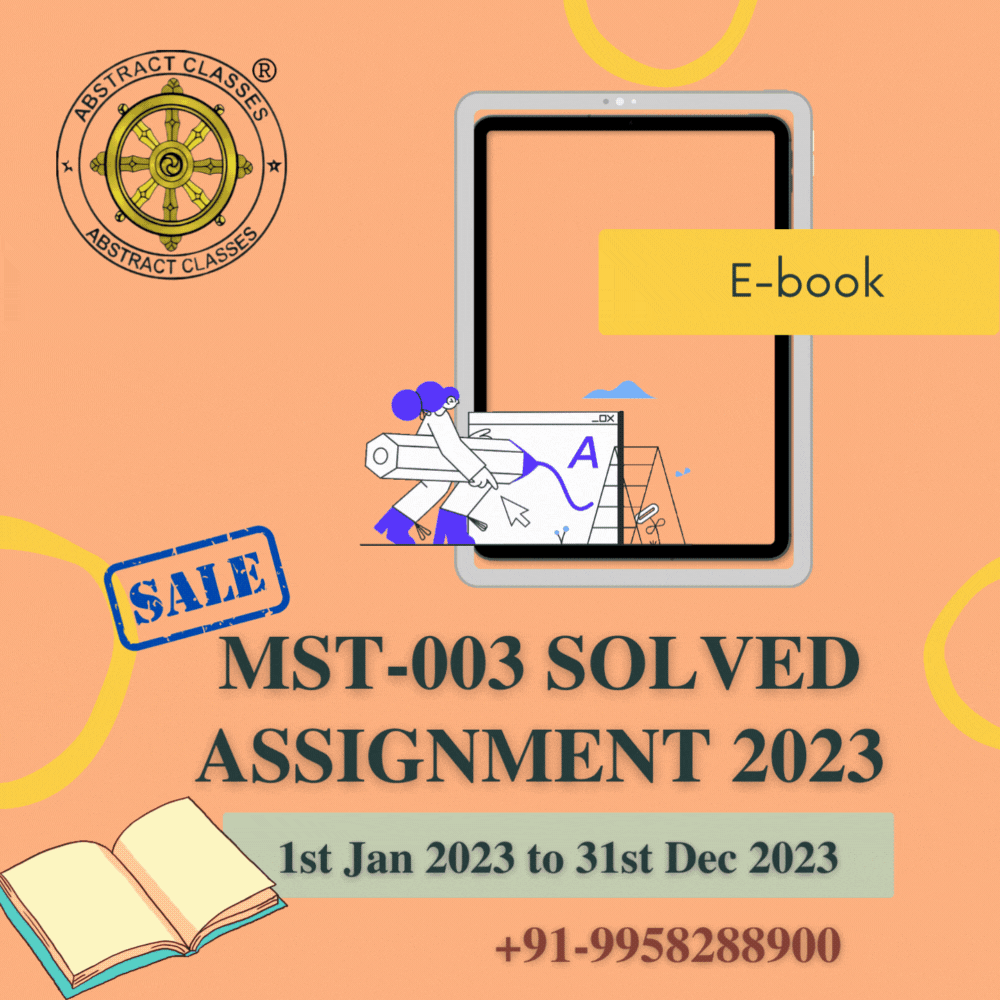₹49.00
Share with your Friends
IGNOU BBYCT-133 Assignment Question Paper 2024
bbyct-133-qp-8648076a-dc1c-446a-986b-96f21861d046
- a) Describe the numerical and structural attributes of population.
b) Discuss the interactions in a community. - a) Discuss the origin and formation of soil.
b) What are the factors affecting soil formation? - Discuss the different factors affecting distribution of insolation.
- Discuss the adaptations in aquatic plants.
- a) Discuss the succession in oak forest.
b) Describe the stages in a hydrosere. - Write a note on taxonomic evidence from phytochemistry.
- a) Discuss the salient features of structure of taxonomic hierarchy.
b) Write a note on the properties of hierarchical system. - a) What are the salient features of preamble of ICN?
b) What are holotype and neotype? - Write short notes on:
i) Apomorphic and Plesiomorphic Characters
ii) Biodiversity hotspot areas in India
iii) Double channel energy flow model
iv) Carbon cycle - Discuss the analytical characters of a plant community.
BBYCT-133 Sample Solution 2024
bbyct-133-solved-assignment-2024-ss-45114454-be05-4d83-b2ef-702fd3537805
- a) Describe the numerical and structural attributes of population.
Numerical Attributes
- Population Size (N): This is the total number of individuals in a population. It’s a fundamental attribute that influences the population’s chances of survival and its impact on the ecosystem.
- Population Density: Refers to the number of individuals per unit area or volume. High density can lead to competition for resources, while low density might indicate challenges in finding mates.
- Population Growth Rate: This measures how fast a population is increasing or decreasing in size. It depends on birth rates, death rates, immigration, and emigration.
- Natality (Birth Rate): The rate at which new individuals are added to the population through birth.
- Mortality (Death Rate): The rate at which individuals are lost from the population due to death.
- Immigration and Emigration: The movement of individuals into (immigration) and out of (emigration) the population, which affects its size and genetic composition.
Structural Attributes
- Age Structure: Refers to the proportion of individuals in different age groups within a population. A typical age structure includes pre-reproductive, reproductive, and post-reproductive age groups.
- Sex Ratio: The ratio of males to females in the population. A balanced sex ratio is often critical for the sustainability of the population, especially in sexually reproducing species.
- Genetic Composition: The genetic diversity within a population, which affects its adaptability to environmental changes and resistance to diseases.
- Spatial Distribution: How individuals in a population are spaced within their habitat. Patterns include clumped, uniform, or random distributions, influenced by factors like resource availability, social interactions, and environmental conditions.
- Social Structure: In species with complex social systems, the organization of individuals into groups (like packs or herds) and their roles and hierarchies can be important.
Importance of Population Attributes
- Conservation and Management: Understanding these attributes is crucial for wildlife management and conservation efforts. For instance, a declining population growth rate or skewed sex ratio can be warning signs requiring conservation actions.
- Ecological Studies: These attributes help in understanding the ecological role of a species, its interaction with the environment, and its impact on ecosystem dynamics.
- Predictive Modeling: They are used in models to predict future trends in population size and structure, which can be essential for long-term planning and conservation strategies.
Conclusion
Types of Interactions in a Community
- Competition:
- Definition: Occurs when individuals or species vie for the same resource that is in limited supply.
- Types: Intraspecific (within a species) and interspecific (between different species).
- Impact: Can lead to resource partitioning, niche specialization, and sometimes exclusion of a species from a habitat.
- Predation:
- Definition: Involves a predator species that hunts and eats another species, the prey.
- Impact: Influences prey populations, can lead to evolutionary adaptations like camouflage or defense mechanisms, and affects the food chain dynamics.
- Parasitism:
- Definition: A relationship where the parasite lives on or in a host organism, deriving nutrients at the host’s expense.
- Impact: Can affect host health and survival, lead to coevolution of host and parasite, and influence population dynamics.
- Mutualism:
- Definition: A symbiotic interaction where both species benefit from the relationship.
- Examples: Pollination (between bees and flowers), nitrogen fixation (between leguminous plants and Rhizobium bacteria).
- Impact: Often critical for the survival and reproduction of one or both species, and can drive major ecological and evolutionary processes.
- Commensalism:
- Definition: A relationship where one species benefits while the other is neither helped nor harmed.
- Examples: Epiphytic plants growing on trees, barnacles attached to whales.
- Impact: Can provide advantages like transportation or habitat for the benefiting species.
- Amensalism:
- Definition: An interaction where one species is inhibited or destroyed while the other is unaffected.
- Examples: A large tree shading out smaller plants, the secretion of antibiotics by fungi.
- Impact: Can influence community structure by inhibiting or reducing certain populations.
Ecological and Evolutionary Implications
- Shaping Communities: These interactions shape the structure, composition, and biodiversity of communities.
- Driving Evolution: Interactions like predation and competition can drive evolutionary changes, leading to adaptations like predator-prey arms races or competitive coevolution.
- Influencing Ecosystem Functions: Interactions impact ecosystem functions such as nutrient cycling, energy flow, and primary productivity.
Conclusion
- a) Discuss the origin and formation of soil.
Key Factors in Soil Formation
- Parent Material: This is the underlying geological material (generally bedrock or a superficial or drift deposit) in which soils form. Soils inherit many characteristics from their parent material, such as mineral composition, texture, and chemical properties.
- Climate: Weather conditions greatly influence the rate of weathering of the parent material and the type of soil formed. Temperature and precipitation are the most important climate factors. They determine the amount of water in the soil and the rate at which chemical and physical weathering occurs.
- Living Organisms: Plants, animals, microorganisms, and humans affect soil formation. Plants contribute organic matter and nutrients to the soil through leaf fall and root decay. Microorganisms help in the decomposition of organic matter, releasing nutrients back into the soil. Animals can modify soils through activities like burrowing, which helps in aerating the soil. Human activities, such as agriculture and urbanization, significantly alter soil characteristics.
- Topography: The shape and slope of the landscape can influence soil formation. Slope and aspect affect the moisture and temperature of soil. Steep slopes may lead to erosion, while flat areas may be prone to waterlogging. Elevation can also impact climate conditions, and thus soil formation.
- Time: Soil formation is a slow process. It takes hundreds to thousands of years for a significant layer of soil to develop. Over time, soils undergo changes and develop layers, known as soil horizons, including topsoil (rich in organic material) and subsoil (rich in minerals).
Soil Formation Processes
- Weathering of Rocks: The primary step in soil formation is the weathering of rock (physical, chemical, and biological), which breaks down the rock into smaller particles. Physical weathering includes freeze-thaw cycles and thermal expansion, while chemical weathering involves processes like hydrolysis, oxidation, and carbonation.
- Addition of Organic Material: The incorporation of organic matter from decaying plants and animals adds nutrients and improves the soil structure.
- Leaching and Eluviation: Water moving through soil can leach away soluble materials, and finer particles can be transported (eluviated) from the upper to lower layers.
- Horizon Formation: Different layers (horizons) form in the soil as a result of organic matter accumulation, leaching, and human or animal activity.
Conclusion
Frequently Asked Questions (FAQs)
You can access the Complete Solution through our app, which can be downloaded using this link:
Simply click “Install” to download and install the app, and then follow the instructions to purchase the required assignment solution. Currently, the app is only available for Android devices. We are working on making the app available for iOS in the future, but it is not currently available for iOS devices.
Yes, It is Complete Solution, a comprehensive solution to the assignments for IGNOU. Valid from January 1, 2023 to December 31, 2023.
Yes, the Complete Solution is aligned with the IGNOU requirements and has been solved accordingly.
Yes, the Complete Solution is guaranteed to be error-free.The solutions are thoroughly researched and verified by subject matter experts to ensure their accuracy.
As of now, you have access to the Complete Solution for a period of 6 months after the date of purchase, which is sufficient to complete the assignment. However, we can extend the access period upon request. You can access the solution anytime through our app.
The app provides complete solutions for all assignment questions. If you still need help, you can contact the support team for assistance at Whatsapp +91-9958288900
No, access to the educational materials is limited to one device only, where you have first logged in. Logging in on multiple devices is not allowed and may result in the revocation of access to the educational materials.
Payments can be made through various secure online payment methods available in the app.Your payment information is protected with industry-standard security measures to ensure its confidentiality and safety. You will receive a receipt for your payment through email or within the app, depending on your preference.
The instructions for formatting your assignments are detailed in the Assignment Booklet, which includes details on paper size, margins, precision, and submission requirements. It is important to strictly follow these instructions to facilitate evaluation and avoid delays.
Terms and Conditions
- The educational materials provided in the app are the sole property of the app owner and are protected by copyright laws.
- Reproduction, distribution, or sale of the educational materials without prior written consent from the app owner is strictly prohibited and may result in legal consequences.
- Any attempt to modify, alter, or use the educational materials for commercial purposes is strictly prohibited.
- The app owner reserves the right to revoke access to the educational materials at any time without notice for any violation of these terms and conditions.
- The app owner is not responsible for any damages or losses resulting from the use of the educational materials.
- The app owner reserves the right to modify these terms and conditions at any time without notice.
- By accessing and using the app, you agree to abide by these terms and conditions.
- Access to the educational materials is limited to one device only. Logging in to the app on multiple devices is not allowed and may result in the revocation of access to the educational materials.
Our educational materials are solely available on our website and application only. Users and students can report the dealing or selling of the copied version of our educational materials by any third party at our email address (abstract4math@gmail.com) or mobile no. (+91-9958288900).
In return, such users/students can expect free our educational materials/assignments and other benefits as a bonafide gesture which will be completely dependent upon our discretion.
Related products

IGNOU MPC-001 Solved Assignment 2022-2023 | MAPC | Cognitive Psychology, Learning and Memory
₹101.00Please read the following points before ordering this IGNOU Assignment Solution.
Categories: IGNOU Assignment Solution, M.A. Psychology, MAPC 2022-2023 Tags: "IGNOU, 2022-2023, Buy IGNOU MPC-001 Assignment, Cognitive Psychology, Cognitive Psychology Assignment, IGNOU Assignment Solutions, IGNOU MAPC Assignment, IGNOU MPC-001, Learning, Learning and Memory Assignment, MAPC, Memory, MPC-001, Solved Assignment, Solved Assignment 2022-2023
IGNOU MEG-17 Solved Assignment 2022-2023 | MEG | American Drama
₹101.00Please read the following points before ordering this IGNOU Assignment Solution.
Categories: IGNOU Assignment Solution, MA MEG, MA MEG 2022-2023 Tags: "IGNOU, 2022-2023, American Drama, Assignments, Expert-written, expert-written assignments, IGNOU MEG-17, IGNOU MEG-17 assignment solutions., IGNOU MEG-17 Solved Assignment, IGNOU Solved Assignments, MEG, solutions., Solved Assignment
IGNOU MEG-15 Solved Assignment 2022-2023 | MEG | Comparative Literature: Theory and Practice
₹101.00Please read the following points before ordering this IGNOU Assignment Solution.
Categories: IGNOU Assignment Solution, MA MEG, MA MEG 2022-2023 Tags: Comparative Literature, IGNOU Assignment Solutions, IGNOU MEG, IGNOU MEG-15 Assignment 2022-2023, IGNOU MEG-15 Solved Assignment, MEG, MEG-15 Assignment 2022-2023, MEG-15 Solved Assignment, MEG-15 Solved Assignment 2022-2023, Theory and Practice.
IGNOU MST-003 Solved Assignment 2023 | PGDAST
₹351.00Access via our Android App Only
Please read the following points before ordering :
Categories: IGNOU Assignment Solution, PGDAST, PGDAST 2023 Tags: 2023 assignments, Expert-written, IGNOU assignments, IGNOU course materials, IGNOU distance learning, IGNOU MST-003, ignou pgdast assignment solution 2023, ignou pgdast solved assignment 2023, IGNOU study materials, IGNOU study resources., mst-003 assignment solution, mst-003 assignment solution 2023, mst-003 solved assignment, mst-003 solved assignment 2023, mst003 assignment solution, mst003 assignment solution 2023, mst003 solved assignment, mst003 solved assignment 2023, mst03 assignment solution, mst03 assignment solution 2023, mst03 solved assignment, mst03 solved assignment 2023, mst3 assignment solution, mst3 assignment solution 2023, mst3 solved assignment, mst3 solved assignment 2023, PGDAST, Probability Theory assignment solution, Probability Theory solved assignment, Solved assignments
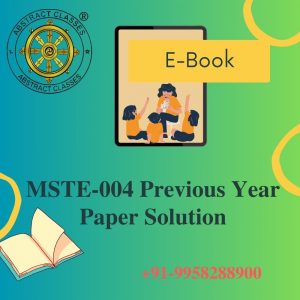
IGNOU MSTE-004 Previous Year Paper Solution | PGDAST
₹365.00Solved Papers – Dec 2022 to Dec 2023 (Total 3 Papers)
Access via our Android App or any Web browser.
Please read the following points before ordering :
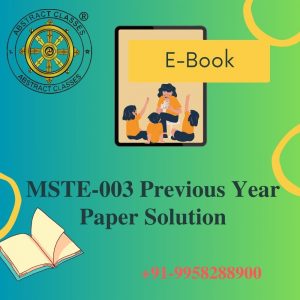
IGNOU MSTE-003 Previous Year Paper Solution | PGDAST
₹365.00Solved Papers – Dec 2022 to Dec 2023 (Total 3 Papers)
Access via our Android App or any Web browser.
Please read the following points before ordering :
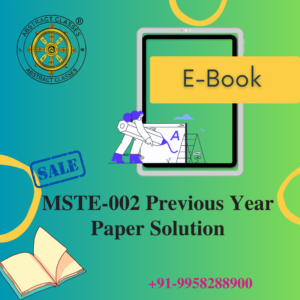
IGNOU MSTE-002 Previous Year Paper Solution | PGDAST
₹365.00Solved Papers – June 2015 to Dec 2023 (Total 18 Papers)
Access via our Android App or any Web browser.
Please read the following points before ordering :

IGNOU MSTE-001 Previous Year Paper Solution | PGDAST
₹365.00Solved Papers – Dec 2015 to Dec 2023 (Total 17 Papers)
Access via our Android App or any Web browser.
Please read the following points before ordering :
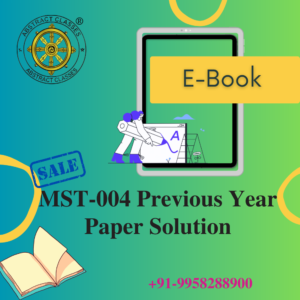
IGNOU MST-004 Previous Year Paper Solution | PGDAST
₹365.00Solved Papers – June 2015 to Dec 2023 (Total 18 Papers)
Access via our Android App or any Web browser.
Please read the following points before ordering :

IGNOU MST-019 Solved Assignment 2024 | MSCAST | IGNOU
₹365.00Access via our Android App Only
Please read the following points before ordering :

IGNOU MST-018 Solved Assignment 2024 | MSCAST | IGNOU
₹365.00Access via our Android App Only
Please read the following points before ordering :

IGNOU MST-017 Solved Assignment 2024 | MSCAST | IGNOU
₹365.00Access via our Android App Only
Please read the following points before ordering :

IGNOU MST-016 Solved Assignment 2024 | MSCAST | IGNOU
₹365.00Access via our Android App Only
Please read the following points before ordering :

IGNOU MPH-005 Solved Assignment 2024 | MSCPH | IGNOU
₹365.00Access via our Android App Only
Please read the following points before ordering :

IGNOU MPH-004 Solved Assignment 2024 | MSCPH | IGNOU
₹365.00Access via our Android App Only
Please read the following points before ordering :

IGNOU MPH-003 Solved Assignment 2024 | MSCPH | IGNOU
₹365.00Access via our Android App Only
Please read the following points before ordering :

IGNOU MPH-002 Solved Assignment 2024 | MSCPH | IGNOU
₹365.00Access via our Android App Only
Please read the following points before ordering :

IGNOU MPH-001 Solved Assignment 2024 | MSCPH | IGNOU
₹365.00Access via our Android App Only
Please read the following points before ordering :

IGNOU BZYET-143 Solved Assignment 2024 | B.Sc. CBCS Zoology
₹49.00Please read the following points before ordering this IGNOU Assignment Solution.

IGNOU BZYET-141 Solved Assignment 2024 | B.Sc. CBCS Zoology
₹49.00Please read the following points before ordering this IGNOU Assignment Solution.

IGNOU BZYCT-137 Solved Assignment 2024 | B.Sc. CBCS Zoology
₹49.00Please read the following points before ordering this IGNOU Assignment Solution.

IGNOU BZYCT-135 Solved Assignment 2024 | B.Sc. CBCS Zoology
₹49.00Please read the following points before ordering this IGNOU Assignment Solution.

IGNOU MMT-007 Solved Assignment 2024 | M.Sc. MACS
₹365.00Access via our Android App Only
Please read the following points before ordering :

IGNOU MMT-005 Solved Assignment 2024 | M.Sc. MACS
₹365.00Access via our Android App Only
Please read the following points before ordering :

IGNOU MMT-004 Solved Assignment 2024 | M.Sc. MACS
₹365.00Access via our Android App Only
Please read the following points before ordering :

IGNOU MMT-002 Solved Assignment 2024 | M.Sc. MACS
₹365.00Access via our Android App Only
Please read the following points before ordering :

IGNOU MMT-001 Solved Assignment 2024 | M.Sc. MACS
₹365.00Access via our Android App Only
Please read the following points before ordering :

IGNOU MMT-008 Solved Assignment 2024 | M.Sc. MACS
₹365.00Access via our Android App Only
Please read the following points before ordering :

IGNOU MMTE-001 Solved Assignment 2024 | M.Sc. MACS
₹365.00Access via our Android App Only
Please read the following points before ordering :

IGNOU MMTE-002 Solved Assignment 2024 | M.Sc. MACS
₹365.00Access via our Android App Only
Please read the following points before ordering :

IGNOU MMT-009 Solved Assignment 2024 | M.Sc. MACS
₹365.00Access via our Android App Only
Please read the following points before ordering :

IGNOU MMTE-004 Solved Assignment 2024 | M.Sc. MACS
₹365.00Access via our Android App Only
Please read the following points before ordering :

IGNOU MMTE-003 Solved Assignment 2024 | M.Sc. MACS
₹365.00Access via our Android App Only
Please read the following points before ordering :

IGNOU MMT-006 Solved Assignment 2024 | M.Sc. MACS
₹365.00Access via our Android App Only
Please read the following points before ordering :

IGNOU MMT-003 Solved Assignment 2024 | M.Sc. MACS
₹365.00Access via our Android App Only
Please read the following points before ordering :

IGNOU BCHET-147 Solved Assignment 2024 | B.Sc. CBCS Chemistry
₹49.00Please read the following points before ordering this IGNOU Assignment Solution.

IGNOU BCHET-141 Solved Assignment 2024 | B.Sc. CBCS Chemistry
₹49.00Please read the following points before ordering this IGNOU Assignment Solution.

IGNOU BCHCT-137 Solved Assignment 2024 | B.Sc. CBCS Chemistry
₹49.00Please read the following points before ordering this IGNOU Assignment Solution.

IGNOU BCHCT-135 Solved Assignment 2024 | B.Sc. CBCS Chemistry
₹49.00Please read the following points before ordering this IGNOU Assignment Solution.

IGNOU BPHET-143 Solved Assignment 2024 | B.Sc (G) CBCS
₹101.00Please read the following points before ordering this IGNOU Assignment Solution.

IGNOU BPHET-141 Solved Assignment 2024 | B.Sc (G) CBCS
₹101.00Please read the following points before ordering this IGNOU Assignment Solution.

IGNOU BPHCT-137 Solved Assignment 2024 | B.Sc (G) CBCS
₹101.00Please read the following points before ordering this IGNOU Assignment Solution.

IGNOU BPHCT-135 Solved Assignment 2024 | B.Sc (G) CBCS
₹101.00Please read the following points before ordering this IGNOU Assignment Solution.

IGNOU BPHCT-133 Solved Assignment 2024 | B.Sc (G) CBCS
₹101.00Please read the following points before ordering this IGNOU Assignment Solution.

IGNOU BPHCT-131 Solved Assignment 2024 | B.Sc (G) CBCS
₹101.00Please read the following points before ordering this IGNOU Assignment Solution.

IGNOU BBYET-143 Solved Assignment 2024 | B.Sc. CBCS Botany
₹49.00Please read the following points before ordering this IGNOU Assignment Solution.

IGNOU BBYET-141 Solved Assignment 2024 | B.Sc. CBCS Botany
₹49.00Please read the following points before ordering this IGNOU Assignment Solution.

IGNOU BBYCT-137 Solved Assignment 2024 | B.Sc. CBCS Botany
₹49.00Please read the following points before ordering this IGNOU Assignment Solution.

IGNOU BBYCT-135 Solved Assignment 2024 | B.Sc. CBCS Botany
₹49.00Please read the following points before ordering this IGNOU Assignment Solution.

IGNOU BBYCT-133 Solved Assignment 2024 | B.Sc. CBCS Botany
₹49.00Please read the following points before ordering this IGNOU Assignment Solution.

IGNOU BBYCT-131 Solved Assignment 2024 | B.Sc. CBCS Botany
₹49.00Please read the following points before ordering this IGNOU Assignment Solution.

IGNOU BZYCT-133 Solved Assignment 2024 | B.Sc. CBCS Zoology
₹49.00Please read the following points before ordering this IGNOU Assignment Solution.

IGNOU BZYCT-131 Solved Assignment 2024 | B.Sc. CBCS Zoology
₹49.00Please read the following points before ordering this IGNOU Assignment Solution.

IGNOU BCHCT-133 Solved Assignment 2024 | B.Sc. CBCS Chemistry
₹49.00Please read the following points before ordering this IGNOU Assignment Solution.

IGNOU BCHCT-131 Solved Assignment 2024 | B.Sc. CBCS Chemistry
₹49.00Please read the following points before ordering this IGNOU Assignment Solution.

IGNOU BEGAE-182 Solved Assignment 2024 | CBCS
₹49.00Please read the following points before ordering this IGNOU Assignment Solution.

IGNOU BEVAE-181 Solved Assignment 2024 | B.Sc (G) CBCS AECC
₹49.00Please read the following points before ordering this IGNOU Assignment Solution.

IGNOU BMTC-132 Solved Assignment 2024 | B.Sc (G) CBCS
₹101.00Please read the following points before ordering this IGNOU Assignment Solution.

IGNOU BMTC-131 Solved Assignment 2024 | B.Sc (G) CBCS
₹101.00Please read the following points before ordering this IGNOU Assignment Solution.

IGNOU BMTC-133 Solved Assignment 2024 | B.Sc (G) CBCS
₹101.00Please read the following points before ordering this IGNOU Assignment Solution.

IGNOU BMTC-134 Solved Assignment 2024 | B.Sc (G) CBCS
₹101.00Please read the following points before ordering this IGNOU Assignment Solution.

IGNOU BMTE-144 Solved Assignment 2024 | B.Sc (G) CBCS
₹101.00Please read the following points before ordering this IGNOU Assignment Solution.

IGNOU BMTE-141 Solved Assignment 2024 | B.Sc (G) CBCS
₹101.00Please read the following points before ordering this IGNOU Assignment Solution.

IGNOU MSTE-004 Solved Assignment 2024 | PGDAST
₹351.00Access via our Android App Only
Please read the following points before ordering :

IGNOU MSTE-003 Solved Assignment 2024 | PGDAST
₹351.00Access via our Android App Only
Please read the following points before ordering :

IGNOU MSTE-002 Solved Assignment 2024 | PGDAST
₹351.00Access via our Android App Only
Please read the following points before ordering :

IGNOU MSTE-001 Solved Assignment 2024 | PGDAST
₹351.00Access via our Android App Only
Please read the following points before ordering :

IGNOU MST-005 Solved Assignment 2024 | PGDAST
₹351.00Access via our Android App Only
Please read the following points before ordering :

IGNOU MST-004 Solved Assignment 2024 | PGDAST
₹351.00Access via our Android App Only
Please read the following points before ordering :

IGNOU MST-003 Solved Assignment 2024 | PGDAST
₹351.00Access via our Android App Only
Please read the following points before ordering :

IGNOU MST-002 Solved Assignment 2024 | PGDAST
₹351.00Access via our Android App Only
Please read the following points before ordering :

IGNOU MST-001 Solved Assignment 2024 | PGDAST
₹351.00Access via our Android App Only
Please read the following points before ordering :
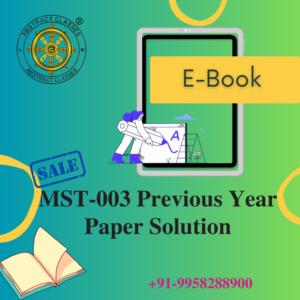
IGNOU MST-003 Previous Year Paper Solution | PGDAST
₹365.00Solved Papers – June 2015 to Dec 2023 (Total 18 Papers)
Access via our Android App or any Web browser.
Please read the following points before ordering :
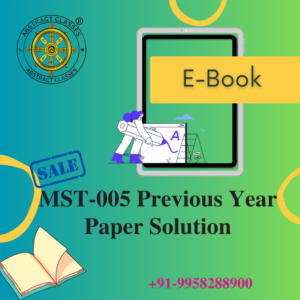
IGNOU MST-005 Previous Year Paper Solution | PGDAST
₹365.00Solved Papers – Dec 2015 to Dec 2023 (Total 17 Papers)
Access via our Android App or any Web browser.
Please read the following points before ordering :
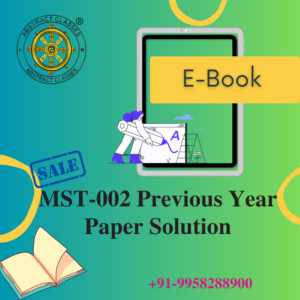
IGNOU MST-002 Previous Year Paper Solution | PGDAST
₹365.00Solved Papers – June 2015 to Dec 2023 (Total 18 Papers)
Access via our Android App or any Web browser.
Please read the following points before ordering :

IGNOU MMTE-001 Solved Assignment 2023 | M.Sc. MACS
₹365.00Access via our Android App Only
Please read the following points before ordering :
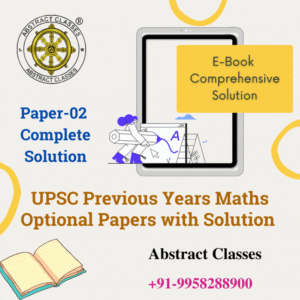
UPSC Previous Years Maths Optional Papers with Solution | Paper-02
₹1,095.00Available on our Android App as well.
Please read the following points before ordering :

UPSC Previous Years Maths Optional Papers with Solution | Paper-01
₹1,095.00Available on our Android App as well.
Please read the following points before ordering :

IGNOU MST-015 Solved Assignment 2023 | MSCAST
₹365.00Access via our Android App Only
Please read the following points before ordering :

IGNOU MST-014 Solved Assignment 2023 | MSCAST
₹365.00Access via our Android App Only
Please read the following points before ordering :

IGNOU MST-013 Solved Assignment 2023 | MSCAST
₹365.00Access via our Android App Only
Please read the following points before ordering :

IGNOU MST-012 Solved Assignment 2023 | MSCAST
₹365.00Access via our Android App Only
Please read the following points before ordering :

IGNOU MST-011 Solved Assignment 2023 | MSCAST
₹365.00Access via our Android App Only
Please read the following points before ordering :

IGNOU MMT-008 Solved Assignment 2023 | M.Sc. MACS
₹365.00Access via our Android App Only
Please read the following points before ordering :
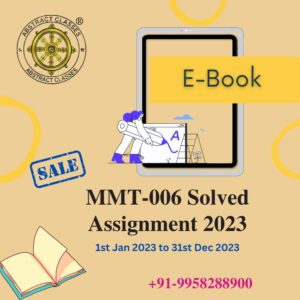
IGNOU MMT-006 Solved Assignment 2023 | M.Sc. MACS
₹365.00Access via our Android App Only
Please read the following points before ordering :

IGNOU MMT-003 Solved Assignment 2023 | M.Sc. MACS
₹365.00Access via our Android App Only
Please read the following points before ordering :
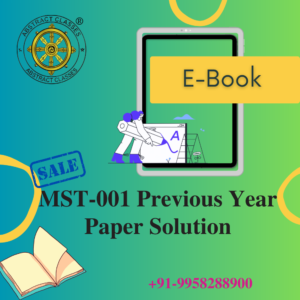
IGNOU MST-001 Previous Year Paper Solution | PGDAST
₹365.00Solved Papers – June 2015 to Dec 2023 (Total 18 Papers)
Access via our Android App or any Web browser.
Please read the following points before ordering :

IGNOU MEV-019 Solved Assignment 2023-2024 | MSCENV
₹101.00Access via our Android App Only
Please read the following points before ordering :

IGNOU MEV-018 Solved Assignment 2023-2024 | MSCENV
₹101.00Access via our Android App Only
Please read the following points before ordering :

IGNOU MEV-017 Solved Assignment 2023-2024 | MSCENV
₹101.00Access via our Android App Only
Please read the following points before ordering :

IGNOU MEV-016 Solved Assignment 2023-2024 | MSCENV
₹101.00Access via our Android App Only
Please read the following points before ordering :

IGNOU MEV-015 Solved Assignment 2023-2024 | MSCENV
₹101.00Access via our Android App Only
Please read the following points before ordering :

IGNOU MEV-014 Solved Assignment 2023-2024 | MSCENV
₹101.00Access via our Android App Only
Please read the following points before ordering :

IGNOU MEV-013 Solved Assignment 2023-2024 | MSCENV
₹101.00Access via our Android App Only
Please read the following points before ordering :

IGNOU MEV-012 Solved Assignment 2023-2024 | MSCENV
₹101.00Access via our Android App Only
Please read the following points before ordering :

IGNOU MEV-011 Solved Assignment 2023-2024 | MSCENV
₹101.00Access via our Android App Only
Please read the following points before ordering :

IGNOU BCHET-149 Solved Assignment 2023 | B.Sc (G) CBCS
₹101.00Please read the following points before ordering this IGNOU Assignment Solution.

IGNOU BCHET-147 Solved Assignment 2023 | B.Sc (G) CBCS
₹101.00Please read the following points before ordering this IGNOU Assignment Solution.

IGNOU BCHET-141 Solved Assignment 2023 | B.Sc (G) CBCS
₹101.00Please read the following points before ordering this IGNOU Assignment Solution.

IGNOU BCHCT-137 Solved Assignment 2023 | B.Sc (G) CBCS
₹101.00Please read the following points before ordering this IGNOU Assignment Solution.

IGNOU BCHCT-135 Solved Assignment 2023 | B.Sc (G) CBCS
₹101.00Please read the following points before ordering this IGNOU Assignment Solution.

IGNOU BPHET-143 Solved Assignment 2023 | B.Sc. CBCS
₹101.00Access via our Android App Only
Please read the following points before ordering :

IGNOU BPHET-141 Solved Assignment 2023 | B.Sc. CBCS
₹101.00Access via our Android App Only
Please read the following points before ordering :

IGNOU BPHCT-137 Solved Assignment 2023 | B.Sc. CBCS
₹101.00Access via our Android App Only
Please read the following points before ordering :

IGNOU BPHCT-135 Solved Assignment 2023 | B.Sc. CBCS
₹101.00Access via our Android App Only
Please read the following points before ordering :

IGNOU BMTE-144 Solved Assignment 2023 | B.Sc (G) CBCS
₹101.00Please read the following points before ordering this IGNOU Assignment Solution.

IGNOU MEG-19 Solved Assignment 2023-2024 | MA MEG
₹101.00Access via our Android App Only
Please read the following points before ordering :

IGNOU MEG-18 Solved Assignment 2023-2024 | MA MEG
₹101.00Access via our Android App Only
Please read the following points before ordering :

IGNOU MEG-17 Solved Assignment 2023-2024 | MA MEG
₹101.00Access via our Android App Only
Please read the following points before ordering :

IGNOU MEG-16 Solved Assignment 2023-2024 | MA MEG
₹101.00Access via our Android App Only
Please read the following points before ordering :

IGNOU MEG-15 Solved Assignment 2023-2024 | MA MEG
₹101.00Access via our Android App Only
Please read the following points before ordering :

IGNOU MEG-14 Solved Assignment 2023-2024 | MA MEG
₹101.00Access via our Android App Only
Please read the following points before ordering :

IGNOU MEG-13 Solved Assignment 2023-2024 | MA MEG
₹101.00Access via our Android App Only
Please read the following points before ordering :

IGNOU MEG-12 Solved Assignment 2023-2024 | MA MEG
₹101.00Access via our Android App Only
Please read the following points before ordering :

IGNOU MEG-11 Solved Assignment 2023-2024 | MA MEG
₹101.00Access via our Android App Only
Please read the following points before ordering :

IGNOU MEG-10 Solved Assignment 2023-2024 | MA MEG
₹101.00Access via our Android App Only
Please read the following points before ordering :

IGNOU MEG-09 Solved Assignment 2023-2024 | MA MEG
₹101.00Access via our Android App Only
Please read the following points before ordering :

IGNOU MEG-08 Solved Assignment 2023-2024 | MA MEG
₹101.00Access via our Android App Only
Please read the following points before ordering :

IGNOU MEG-07 Solved Assignment 2023-2024 | MA MEG
₹101.00Access via our Android App Only
Please read the following points before ordering :

IGNOU MEG-06 Solved Assignment 2023-2024 | MA MEG
₹101.00Access via our Android App Only
Please read the following points before ordering :

IGNOU MEG-05 Solved Assignment 2023-2024 | MA MEG
₹101.00Access via our Android App Only
Please read the following points before ordering :

IGNOU MEG-04 Solved Assignment 2023-2024 | MA MEG
₹101.00Access via our Android App Only
Please read the following points before ordering :

IGNOU MEG-03 Solved Assignment 2023-2024 | MA MEG
₹101.00Access via our Android App Only
Please read the following points before ordering :

IGNOU MEG-02 Solved Assignment 2023-2024 | MA MEG
₹101.00Access via our Android App Only
Please read the following points before ordering :

IGNOU MEG-01 Solved Assignment 2023-2024 | MA MEG
₹101.00Access via our Android App Only
Please read the following points before ordering :

IGNOU MMT-007 Solved Assignment 2023 | M.Sc. MACS
₹351.00Access via our Android App Only
Please read the following points before ordering :
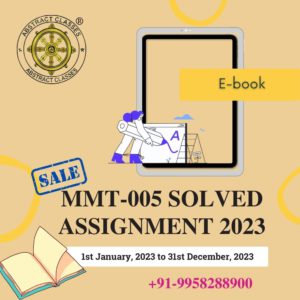
IGNOU MMT-005 Solved Assignment 2023 | M.Sc. MACS
₹351.00Access via our Android App Only
Please read the following points before ordering :

IGNOU MMT-004 Solved Assignment 2023 | M.Sc. MACS
₹351.00Access via our Android App Only
Please read the following points before ordering :

IGNOU MMT-002 Solved Assignment 2023 | M.Sc. MACS
₹351.00Access via our Android App Only
Please read the following points before ordering :
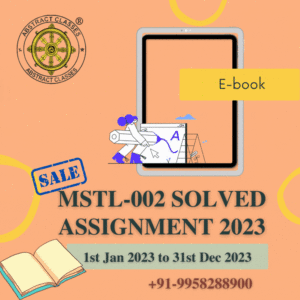
IGNOU MSTL-002 Solved Assignment 2023 | PGDAST
₹401.00Access via our Android App Only
Please read the following points before ordering :
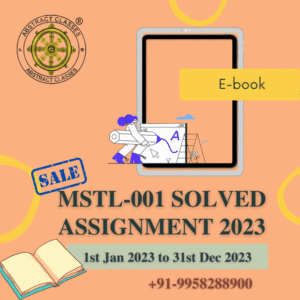
IGNOU MSTL-001 Solved Assignment 2023 | PGDAST
₹401.00Access via our Android App Only
Please read the following points before ordering :

IGNOU PHE-06 Solved Assignment 2023
₹201.00Please read the following points before ordering this IGNOU Assignment Solution.

IGNOU BCHCT-133 Solved Assignment 2023 | B.Sc (G) CBCS
₹101.00Please read the following points before ordering this IGNOU Assignment Solution.

IGNOU BCHCT-131 Solved Assignment 2023 | B.Sc (G) CBCS
₹101.00Please read the following points before ordering this IGNOU Assignment Solution.

IGNOU BPHCT-133 Solved Assignment 2023 | B.Sc (G) CBCS
₹101.00Please read the following points before ordering this IGNOU Assignment Solution.

IGNOU BPHCT-131 Solved Assignment 2023 | B.Sc (G) CBCS
₹101.00Please read the following points before ordering this IGNOU Assignment Solution.
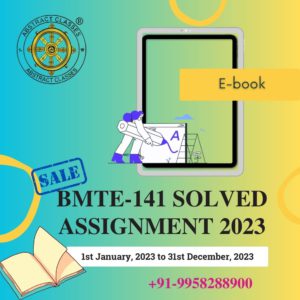
IGNOU BMTE-141 Solved Assignment 2023 | B.Sc (G) CBCS
₹101.00Please read the following points before ordering this IGNOU Assignment Solution.
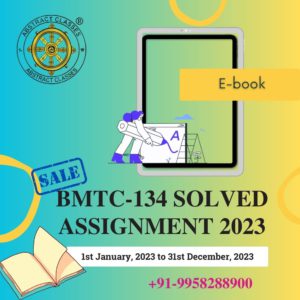
IGNOU BMTC-134 Solved Assignment 2023 | B.Sc (G) CBCS
₹101.00Please read the following points before ordering this IGNOU Assignment Solution.
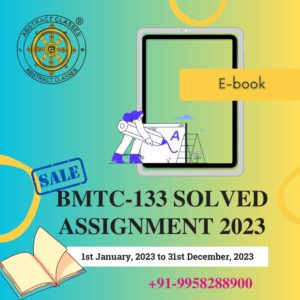
IGNOU BMTC-133 Solved Assignment 2023 | B.Sc (G) CBCS
₹101.00Please read the following points before ordering this IGNOU Assignment Solution.

IGNOU BMTC-132 Solved Assignment 2023 | B.Sc (G) CBCS
₹101.00Please read the following points before ordering this IGNOU Assignment Solution.
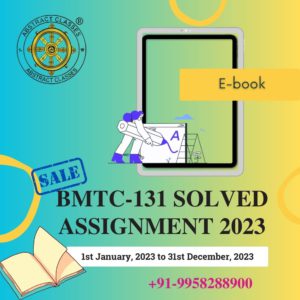
IGNOU BMTC-131 Solved Assignment 2023 | B.Sc (G) CBCS
₹101.00Please read the following points before ordering this IGNOU Assignment Solution.
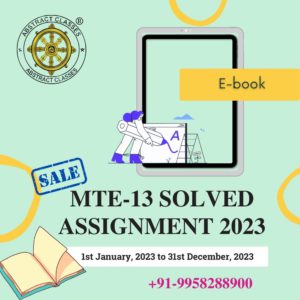
IGNOU MTE-13 Solved Assignment 2023 | MTE
₹251.00Please read the following points before ordering this IGNOU Assignment Solution.

IGNOU MTE-12 Solved Assignment 2023 | MTE
₹251.00Please read the following points before ordering this IGNOU Assignment Solution.
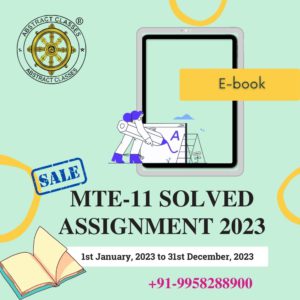
IGNOU MTE-11 Solved Assignment 2023 | MTE
₹251.00Please read the following points before ordering this IGNOU Assignment Solution.

IGNOU MTE-10 Solved Assignment 2023 | MTE
₹201.00Please read the following points before ordering this IGNOU Assignment Solution.

IGNOU MTE-09 Solved Assignment 2023 | MTE
₹201.00Please read the following points before ordering this IGNOU Assignment Solution.

IGNOU MTE-08 Solved Assignment 2023 | MTE
₹201.00Please read the following points before ordering this IGNOU Assignment Solution.

IGNOU MTE-07 Solved Assignment 2023 | MTE
₹201.00Please read the following points before ordering this IGNOU Assignment Solution.
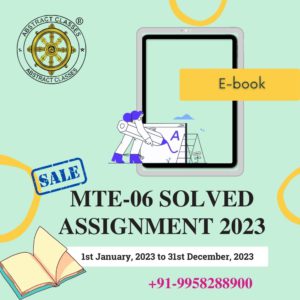
IGNOU MTE-06 Solved Assignment 2023 | MTE
₹151.00Please read the following points before ordering this IGNOU Assignment Solution.
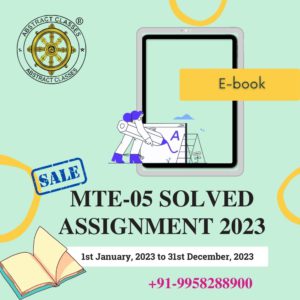
IGNOU MTE-05 Solved Assignment 2023 | MTE
₹151.00Please read the following points before ordering this IGNOU Assignment Solution.
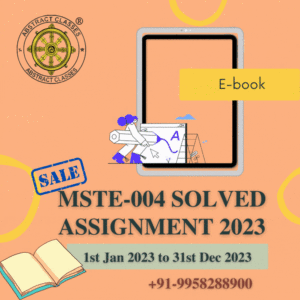
IGNOU MSTE-004 Solved Assignment 2023 | PGDAST
₹351.00Access via our Android App Only
Please read the following points before ordering :

IGNOU MSTE-003 Solved Assignment 2023 | PGDAST
₹351.00Access via our Android App Only
Please read the following points before ordering :

IGNOU MSTE-002 Solved Assignment 2023 | PGDAST
₹351.00Access via our Android App Only
Please read the following points before ordering :

IGNOU MMT-001 Solved Assignment 2023 | MA MACS
₹351.00Access via our Android App Only
Please read the following points before ordering :
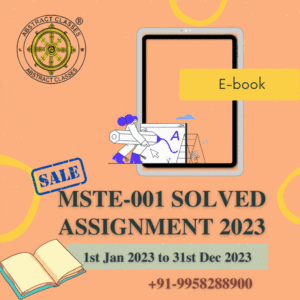
IGNOU MSTE-001 Solved Assignment 2023 | PGDAST
₹351.00Access via our Android App Only
Please read the following points before ordering :

IGNOU MST-005 Solved Assignment 2023 | PGDAST
₹351.00Access via our Android App Only
Please read the following points before ordering :

IGNOU BEVAE-181 Solved Assignment 2022-2023 | BSCG/ BAG/ BCOMG | AECC ON ENVIRONMENTAL STUDIES
₹51.00Please read the following points before ordering this IGNOU Assignment Solution.

IGNOU BEGC-133 Assignment Solution 2022-2023 | BAG | BRITISH LITERATURE
₹51.00Please read the following points before ordering this IGNOU Assignment Solution.

IGNOU BEGC-134 Assignment Solution 2022-2023 | BAG | Reading the Novel
₹51.00Please read the following points before ordering this IGNOU Assignment Solution.

IGNOU BEGLA-137 Assignment Solution 2022-2023 | BAG | Language through Literature
₹51.00Please read the following points before ordering this IGNOU Assignment Solution.

IGNOU BEGLA-138 Assignment Solution 2022-2023 | BAG | Reading & Speaking Skills
₹51.00Please read the following points before ordering this IGNOU Assignment Solution.

IGNOU BEGS-183 Assignment Solution 2022-2023 | BAG | WRITING AND STUDY SKILLS
₹51.00Please read the following points before ordering this IGNOU Assignment Solution.

IGNOU BSOC – 133 Solved Assignment 2022-2023 | BAG | SOCIOLOGICAL THEORIES
₹51.00Please read the following points before ordering this IGNOU Assignment Solution.

IGNOU BSOC – 134 Solved Assignment 2022-2023 | B.A.G | METHODS OF SOCIOLOGICAL ENQUIRY
₹51.00Please read the following points before ordering this IGNOU Assignment Solution.

IGNOU BCOS – 184 Solved Assignment 2022-2023 | B.Com | E-COMMERCE
₹51.00Please read the following points before ordering this IGNOU Assignment Solution.

IGNOU MPC-006 Solved Assignment 2022-2023 | MAPC | STATISTICS IN PSYCHOLOGY
₹101.00Please read the following points before ordering this IGNOU Assignment Solution.

IGNOU MPC-005 Solved Assignment 2022-2023 | MAPC | Research Methods
₹101.00Please read the following points before ordering this IGNOU Assignment Solution.

IGNOU MPC-004 Solved Assignment 2022-2023 | MAPC | ADVANCED SOCIAL PSYCHOLOGY
₹101.00Please read the following points before ordering this IGNOU Assignment Solution.

IGNOU MPC-003 Solved Assignment 2022-2023 | MAPC | PERSONALITY: THEORIES AND ASSESSMENT
₹101.00Please read the following points before ordering this IGNOU Assignment Solution.

IGNOU MPC-002 Solved Assignment 2022-2023 | MAPC | LIFE SPAN PSYCHOLOGY
₹101.00Please read the following points before ordering this IGNOU Assignment Solution.

IGNOU MPC-001 Solved Assignment 2022-2023 | MAPC | Cognitive Psychology, Learning and Memory
₹101.00Please read the following points before ordering this IGNOU Assignment Solution.

IGNOU MEG-19 Solved Assignment 2022-2023 | MEG | THE AUSTRALIAN NOVEL
₹101.00Please read the following points before ordering this IGNOU Assignment Solution.

IGNOU MEG-18 Solved Assignment 2022-2023 | MEG | American Poetry
₹101.00Please read the following points before ordering this IGNOU Assignment Solution.

IGNOU MEG-17 Solved Assignment 2022-2023 | MEG | American Drama
₹101.00Please read the following points before ordering this IGNOU Assignment Solution.

IGNOU MEG-16 Solved Assignment 2022-2023 | MEG | Indian Folk Literature
₹101.00Please read the following points before ordering this IGNOU Assignment Solution.

IGNOU MEG-15 Solved Assignment 2022-2023 | MEG | Comparative Literature: Theory and Practice
₹101.00Please read the following points before ordering this IGNOU Assignment Solution.

IGNOU MEG-14 Solved Assignment 2022-2023 | MEG | Contemporary Indian Literature in English Translation
₹101.00Please read the following points before ordering this IGNOU Assignment Solution.

IGNOU MEG-13 Solved Assignment 2022-2023 | MEG | WRITINGS FROM THE MARGINS
₹101.00Please read the following points before ordering this IGNOU Assignment Solution.

IGNOU MEG-12 Solved Assignment 2022-2023 | MEG | A Survey Course in 20th Century Canadian Literature
₹101.00Please read the following points before ordering this IGNOU Assignment Solution.

IGNOU MEG-11 Solved Assignment 2022-2023 | MEG | AMERICAN NOVEL
₹101.00Please read the following points before ordering this IGNOU Assignment Solution.

IGNOU MEG-10 Solved Assignment 2022-2023 | MEG | ENGLISH STUDIES IN INDIA
₹101.00Please read the following points before ordering this IGNOU Assignment Solution.

IGNOU MEG-09 Solved Assignment 2022-2023 | MEG | Australian Literature
₹101.00Please read the following points before ordering this IGNOU Assignment Solution.

IGNOU MEG-08 Solved Assignment 2022-2023 | MEG | NEW LITERATURES IN ENGLISH
₹101.00Please read the following points before ordering this IGNOU Assignment Solution.

IGNOU MEG-07 Solved Assignment 2022-2023 | MEG | INDIAN ENGLISH LITERATURE
₹101.00Please read the following points before ordering this IGNOU Assignment Solution.

IGNOU MEG-06 Solved Assignment 2022-2023 | MEG | AMERICAN LITERATURE
₹101.00Please read the following points before ordering this IGNOU Assignment Solution.

IGNOU MEG-05 Solved Assignment 2022-2023 | MEG | LITERARY CRITICISM & THEORY
₹101.00Please read the following points before ordering this IGNOU Assignment Solution.

IGNOU MEG-04 Solved Assignment 2022-2023 | MEG | ASPECTS OF LANGUAGE
₹101.00Please read the following points before ordering this IGNOU Assignment Solution.

IGNOU MEG-03 Solved Assignment 2022-2023 | MEG | British Novel
₹101.00Please read the following points before ordering this IGNOU Assignment Solution.

IGNOU MEG-02 Solved Assignment 2022-2023 | MEG | British Drama
₹101.00Please read the following points before ordering this IGNOU Assignment Solution.

IGNOU MEG-01 Solved Assignment 2022-2023 | MEG | British Poetry
₹101.00Please read the following points before ordering this IGNOU Assignment Solution.
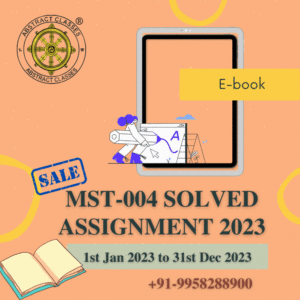
IGNOU MST-004 Solved Assignment 2023 | PGDAST
₹351.00Access via our Android App Only
Please read the following points before ordering :
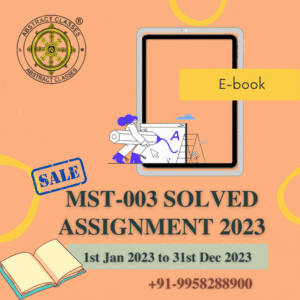
IGNOU MST-003 Solved Assignment 2023 | PGDAST
₹351.00Access via our Android App Only
Please read the following points before ordering :
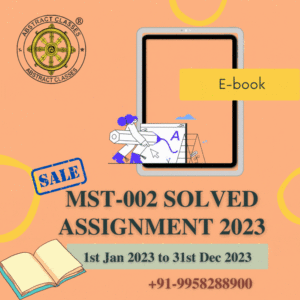
IGNOU MST-002 Solved Assignment 2023 | PGDAST
₹351.00Access via our Android App Only
Please read the following points before ordering :

IGNOU MST-001 Solved Assignment 2023 | PGDAST
₹351.00Access via our Android App Only
Please read the following points before ordering :

Stop and Take a Second
₹110.00Donec pede justo, fringilla vel, aliquet nec, vulputate eget, arcu. In enim justo, rhoncus ut, imperdiet a, venenatis vitae, justo.
There are many variations of passages of Lorem Ipsum available, but the majority have suffered alteration in some form, by injected humour, or randomised words which don’t look even slightly.

Running From Me
₹70.00Donec pede justo, fringilla vel, aliquet nec, vulputate eget, arcu. In enim justo, rhoncus ut, imperdiet a, venenatis vitae, justo.
There are many variations of passages of Lorem Ipsum available, but the majority have suffered alteration in some form, by injected humour, or randomised words which don’t look even slightly.

Red Side Book
₹300.00Donec pede justo, fringilla vel, aliquet nec, vulputate eget, arcu. In enim justo, rhoncus ut, imperdiet a, venenatis vitae, justo.
There are many variations of passages of Lorem Ipsum available, but the majority have suffered alteration in some form, by injected humour, or randomised words which don’t look even slightly.

Real Life Fairytale
₹250.00Donec pede justo, fringilla vel, aliquet nec, vulputate eget, arcu. In enim justo, rhoncus ut, imperdiet a, venenatis vitae, justo.
There are many variations of passages of Lorem Ipsum available, but the majority have suffered alteration in some form, by injected humour, or randomised words which don’t look even slightly.

Note Book Mockup
₹200.00Donec pede justo, fringilla vel, aliquet nec, vulputate eget, arcu. In enim justo, rhoncus ut, imperdiet a, venenatis vitae, justo.
There are many variations of passages of Lorem Ipsum available, but the majority have suffered alteration in some form, by injected humour, or randomised words which don’t look even slightly.

Motivational Book Cover
This story, dazzling in its powerful simplicity and soul-stirring wisdom, is about an Andalusian shepherd boy named Santiago who travels from his homeland in Spain to the Egyptian desert in search of a treasure buried near the Pyramids. Lorem ipsum dolor sit amet, consectetur adipiscing elit, sed do eiusmod tempor incididunt ut labore et. Lorem ipsum dolor sit amet, consectetur adipiscing elit, sed do eiusmod tempor incididunt etc.
1 in stock

Book Cover Softcover
This story, dazzling in its powerful simplicity and soul-stirring wisdom, is about an Andalusian shepherd boy named Santiago who travels from his homeland in Spain to the Egyptian desert in search of a treasure buried near the Pyramids. Lorem ipsum dolor sit amet, consectetur adipiscing elit, sed do eiusmod tempor incididunt ut labore et. Lorem ipsum dolor sit amet, consectetur adipiscing elit, sed do eiusmod tempor incididunt etc.
4 in stock

IGNOU MSTE-004 Previous Year Paper Solution | PGDAST
₹365.00Solved Papers – Dec 2022 to Dec 2023 (Total 3 Papers)
Access via our Android App or any Web browser.
Please read the following points before ordering :

IGNOU MSTE-003 Previous Year Paper Solution | PGDAST
₹365.00Solved Papers – Dec 2022 to Dec 2023 (Total 3 Papers)
Access via our Android App or any Web browser.
Please read the following points before ordering :

IGNOU MSTE-002 Previous Year Paper Solution | PGDAST
₹365.00Solved Papers – June 2015 to Dec 2023 (Total 18 Papers)
Access via our Android App or any Web browser.
Please read the following points before ordering :

IGNOU MSTE-001 Previous Year Paper Solution | PGDAST
₹365.00Solved Papers – Dec 2015 to Dec 2023 (Total 17 Papers)
Access via our Android App or any Web browser.
Please read the following points before ordering :

IGNOU MST-004 Previous Year Paper Solution | PGDAST
₹365.00Solved Papers – June 2015 to Dec 2023 (Total 18 Papers)
Access via our Android App or any Web browser.
Please read the following points before ordering :

IGNOU MST-019 Solved Assignment 2024 | MSCAST | IGNOU
₹365.00Access via our Android App Only
Please read the following points before ordering :

IGNOU MST-018 Solved Assignment 2024 | MSCAST | IGNOU
₹365.00Access via our Android App Only
Please read the following points before ordering :

IGNOU MST-017 Solved Assignment 2024 | MSCAST | IGNOU
₹365.00Access via our Android App Only
Please read the following points before ordering :

IGNOU MST-016 Solved Assignment 2024 | MSCAST | IGNOU
₹365.00Access via our Android App Only
Please read the following points before ordering :

IGNOU MPH-005 Solved Assignment 2024 | MSCPH | IGNOU
₹365.00Access via our Android App Only
Please read the following points before ordering :

IGNOU MPH-004 Solved Assignment 2024 | MSCPH | IGNOU
₹365.00Access via our Android App Only
Please read the following points before ordering :

IGNOU MPH-003 Solved Assignment 2024 | MSCPH | IGNOU
₹365.00Access via our Android App Only
Please read the following points before ordering :

IGNOU MPH-002 Solved Assignment 2024 | MSCPH | IGNOU
₹365.00Access via our Android App Only
Please read the following points before ordering :

IGNOU MPH-001 Solved Assignment 2024 | MSCPH | IGNOU
₹365.00Access via our Android App Only
Please read the following points before ordering :

IGNOU BZYET-143 Solved Assignment 2024 | B.Sc. CBCS Zoology
₹49.00Please read the following points before ordering this IGNOU Assignment Solution.

IGNOU BZYET-141 Solved Assignment 2024 | B.Sc. CBCS Zoology
₹49.00Please read the following points before ordering this IGNOU Assignment Solution.

IGNOU BZYCT-137 Solved Assignment 2024 | B.Sc. CBCS Zoology
₹49.00Please read the following points before ordering this IGNOU Assignment Solution.

IGNOU BZYCT-135 Solved Assignment 2024 | B.Sc. CBCS Zoology
₹49.00Please read the following points before ordering this IGNOU Assignment Solution.

IGNOU MMT-007 Solved Assignment 2024 | M.Sc. MACS
₹365.00Access via our Android App Only
Please read the following points before ordering :

IGNOU MMT-005 Solved Assignment 2024 | M.Sc. MACS
₹365.00Access via our Android App Only
Please read the following points before ordering :

IGNOU MMT-004 Solved Assignment 2024 | M.Sc. MACS
₹365.00Access via our Android App Only
Please read the following points before ordering :

IGNOU MMT-002 Solved Assignment 2024 | M.Sc. MACS
₹365.00Access via our Android App Only
Please read the following points before ordering :

IGNOU MMT-001 Solved Assignment 2024 | M.Sc. MACS
₹365.00Access via our Android App Only
Please read the following points before ordering :

IGNOU MMT-008 Solved Assignment 2024 | M.Sc. MACS
₹365.00Access via our Android App Only
Please read the following points before ordering :

IGNOU MMTE-001 Solved Assignment 2024 | M.Sc. MACS
₹365.00Access via our Android App Only
Please read the following points before ordering :

IGNOU MMTE-002 Solved Assignment 2024 | M.Sc. MACS
₹365.00Access via our Android App Only
Please read the following points before ordering :

IGNOU MMT-009 Solved Assignment 2024 | M.Sc. MACS
₹365.00Access via our Android App Only
Please read the following points before ordering :

IGNOU MMTE-004 Solved Assignment 2024 | M.Sc. MACS
₹365.00Access via our Android App Only
Please read the following points before ordering :

IGNOU MMTE-003 Solved Assignment 2024 | M.Sc. MACS
₹365.00Access via our Android App Only
Please read the following points before ordering :

IGNOU MMT-006 Solved Assignment 2024 | M.Sc. MACS
₹365.00Access via our Android App Only
Please read the following points before ordering :

IGNOU MMT-003 Solved Assignment 2024 | M.Sc. MACS
₹365.00Access via our Android App Only
Please read the following points before ordering :

IGNOU BCHET-147 Solved Assignment 2024 | B.Sc. CBCS Chemistry
₹49.00Please read the following points before ordering this IGNOU Assignment Solution.

IGNOU BCHET-141 Solved Assignment 2024 | B.Sc. CBCS Chemistry
₹49.00Please read the following points before ordering this IGNOU Assignment Solution.

IGNOU BCHCT-137 Solved Assignment 2024 | B.Sc. CBCS Chemistry
₹49.00Please read the following points before ordering this IGNOU Assignment Solution.

IGNOU BCHCT-135 Solved Assignment 2024 | B.Sc. CBCS Chemistry
₹49.00Please read the following points before ordering this IGNOU Assignment Solution.

IGNOU BPHET-143 Solved Assignment 2024 | B.Sc (G) CBCS
₹101.00Please read the following points before ordering this IGNOU Assignment Solution.

IGNOU BPHET-141 Solved Assignment 2024 | B.Sc (G) CBCS
₹101.00Please read the following points before ordering this IGNOU Assignment Solution.

IGNOU BPHCT-137 Solved Assignment 2024 | B.Sc (G) CBCS
₹101.00Please read the following points before ordering this IGNOU Assignment Solution.

IGNOU BPHCT-135 Solved Assignment 2024 | B.Sc (G) CBCS
₹101.00Please read the following points before ordering this IGNOU Assignment Solution.

IGNOU BPHCT-133 Solved Assignment 2024 | B.Sc (G) CBCS
₹101.00Please read the following points before ordering this IGNOU Assignment Solution.

IGNOU BPHCT-131 Solved Assignment 2024 | B.Sc (G) CBCS
₹101.00Please read the following points before ordering this IGNOU Assignment Solution.

IGNOU BBYET-143 Solved Assignment 2024 | B.Sc. CBCS Botany
₹49.00Please read the following points before ordering this IGNOU Assignment Solution.

IGNOU BBYET-141 Solved Assignment 2024 | B.Sc. CBCS Botany
₹49.00Please read the following points before ordering this IGNOU Assignment Solution.

IGNOU BBYCT-137 Solved Assignment 2024 | B.Sc. CBCS Botany
₹49.00Please read the following points before ordering this IGNOU Assignment Solution.

IGNOU BBYCT-135 Solved Assignment 2024 | B.Sc. CBCS Botany
₹49.00Please read the following points before ordering this IGNOU Assignment Solution.

IGNOU BBYCT-133 Solved Assignment 2024 | B.Sc. CBCS Botany
₹49.00Please read the following points before ordering this IGNOU Assignment Solution.

IGNOU BBYCT-131 Solved Assignment 2024 | B.Sc. CBCS Botany
₹49.00Please read the following points before ordering this IGNOU Assignment Solution.

IGNOU BZYCT-133 Solved Assignment 2024 | B.Sc. CBCS Zoology
₹49.00Please read the following points before ordering this IGNOU Assignment Solution.

IGNOU BZYCT-131 Solved Assignment 2024 | B.Sc. CBCS Zoology
₹49.00Please read the following points before ordering this IGNOU Assignment Solution.

IGNOU BCHCT-133 Solved Assignment 2024 | B.Sc. CBCS Chemistry
₹49.00Please read the following points before ordering this IGNOU Assignment Solution.

IGNOU BCHCT-131 Solved Assignment 2024 | B.Sc. CBCS Chemistry
₹49.00Please read the following points before ordering this IGNOU Assignment Solution.

IGNOU BEGAE-182 Solved Assignment 2024 | CBCS
₹49.00Please read the following points before ordering this IGNOU Assignment Solution.

IGNOU BEVAE-181 Solved Assignment 2024 | B.Sc (G) CBCS AECC
₹49.00Please read the following points before ordering this IGNOU Assignment Solution.

IGNOU BMTC-132 Solved Assignment 2024 | B.Sc (G) CBCS
₹101.00Please read the following points before ordering this IGNOU Assignment Solution.

IGNOU BMTC-131 Solved Assignment 2024 | B.Sc (G) CBCS
₹101.00Please read the following points before ordering this IGNOU Assignment Solution.

IGNOU BMTC-133 Solved Assignment 2024 | B.Sc (G) CBCS
₹101.00Please read the following points before ordering this IGNOU Assignment Solution.

IGNOU BMTC-134 Solved Assignment 2024 | B.Sc (G) CBCS
₹101.00Please read the following points before ordering this IGNOU Assignment Solution.

IGNOU BMTE-144 Solved Assignment 2024 | B.Sc (G) CBCS
₹101.00Please read the following points before ordering this IGNOU Assignment Solution.

IGNOU BMTE-141 Solved Assignment 2024 | B.Sc (G) CBCS
₹101.00Please read the following points before ordering this IGNOU Assignment Solution.

IGNOU MSTE-004 Solved Assignment 2024 | PGDAST
₹351.00Access via our Android App Only
Please read the following points before ordering :

IGNOU MSTE-003 Solved Assignment 2024 | PGDAST
₹351.00Access via our Android App Only
Please read the following points before ordering :

IGNOU MSTE-002 Solved Assignment 2024 | PGDAST
₹351.00Access via our Android App Only
Please read the following points before ordering :

IGNOU MSTE-001 Solved Assignment 2024 | PGDAST
₹351.00Access via our Android App Only
Please read the following points before ordering :

IGNOU MST-005 Solved Assignment 2024 | PGDAST
₹351.00Access via our Android App Only
Please read the following points before ordering :

IGNOU MST-004 Solved Assignment 2024 | PGDAST
₹351.00Access via our Android App Only
Please read the following points before ordering :

IGNOU MST-003 Solved Assignment 2024 | PGDAST
₹351.00Access via our Android App Only
Please read the following points before ordering :

IGNOU MST-002 Solved Assignment 2024 | PGDAST
₹351.00Access via our Android App Only
Please read the following points before ordering :

IGNOU MST-001 Solved Assignment 2024 | PGDAST
₹351.00Access via our Android App Only
Please read the following points before ordering :

IGNOU MST-003 Previous Year Paper Solution | PGDAST
₹365.00Solved Papers – June 2015 to Dec 2023 (Total 18 Papers)
Access via our Android App or any Web browser.
Please read the following points before ordering :

IGNOU MST-005 Previous Year Paper Solution | PGDAST
₹365.00Solved Papers – Dec 2015 to Dec 2023 (Total 17 Papers)
Access via our Android App or any Web browser.
Please read the following points before ordering :

IGNOU MST-002 Previous Year Paper Solution | PGDAST
₹365.00Solved Papers – June 2015 to Dec 2023 (Total 18 Papers)
Access via our Android App or any Web browser.
Please read the following points before ordering :

IGNOU MMTE-001 Solved Assignment 2023 | M.Sc. MACS
₹365.00Access via our Android App Only
Please read the following points before ordering :

UPSC Previous Years Maths Optional Papers with Solution | Paper-02
₹1,095.00Available on our Android App as well.
Please read the following points before ordering :

UPSC Previous Years Maths Optional Papers with Solution | Paper-01
₹1,095.00Available on our Android App as well.
Please read the following points before ordering :

IGNOU MST-015 Solved Assignment 2023 | MSCAST
₹365.00Access via our Android App Only
Please read the following points before ordering :

IGNOU MST-014 Solved Assignment 2023 | MSCAST
₹365.00Access via our Android App Only
Please read the following points before ordering :

IGNOU MST-013 Solved Assignment 2023 | MSCAST
₹365.00Access via our Android App Only
Please read the following points before ordering :

IGNOU MST-012 Solved Assignment 2023 | MSCAST
₹365.00Access via our Android App Only
Please read the following points before ordering :

IGNOU MST-011 Solved Assignment 2023 | MSCAST
₹365.00Access via our Android App Only
Please read the following points before ordering :

IGNOU MMT-008 Solved Assignment 2023 | M.Sc. MACS
₹365.00Access via our Android App Only
Please read the following points before ordering :

IGNOU MMT-006 Solved Assignment 2023 | M.Sc. MACS
₹365.00Access via our Android App Only
Please read the following points before ordering :

IGNOU MMT-003 Solved Assignment 2023 | M.Sc. MACS
₹365.00Access via our Android App Only
Please read the following points before ordering :

IGNOU MST-001 Previous Year Paper Solution | PGDAST
₹365.00Solved Papers – June 2015 to Dec 2023 (Total 18 Papers)
Access via our Android App or any Web browser.
Please read the following points before ordering :

IGNOU MEV-019 Solved Assignment 2023-2024 | MSCENV
₹101.00Access via our Android App Only
Please read the following points before ordering :

IGNOU MEV-018 Solved Assignment 2023-2024 | MSCENV
₹101.00Access via our Android App Only
Please read the following points before ordering :

IGNOU MEV-017 Solved Assignment 2023-2024 | MSCENV
₹101.00Access via our Android App Only
Please read the following points before ordering :

IGNOU MEV-016 Solved Assignment 2023-2024 | MSCENV
₹101.00Access via our Android App Only
Please read the following points before ordering :

IGNOU MEV-015 Solved Assignment 2023-2024 | MSCENV
₹101.00Access via our Android App Only
Please read the following points before ordering :

IGNOU MEV-014 Solved Assignment 2023-2024 | MSCENV
₹101.00Access via our Android App Only
Please read the following points before ordering :

IGNOU MEV-013 Solved Assignment 2023-2024 | MSCENV
₹101.00Access via our Android App Only
Please read the following points before ordering :

IGNOU MEV-012 Solved Assignment 2023-2024 | MSCENV
₹101.00Access via our Android App Only
Please read the following points before ordering :

IGNOU MEV-011 Solved Assignment 2023-2024 | MSCENV
₹101.00Access via our Android App Only
Please read the following points before ordering :

IGNOU BCHET-149 Solved Assignment 2023 | B.Sc (G) CBCS
₹101.00Please read the following points before ordering this IGNOU Assignment Solution.

IGNOU BCHET-147 Solved Assignment 2023 | B.Sc (G) CBCS
₹101.00Please read the following points before ordering this IGNOU Assignment Solution.

IGNOU BCHET-141 Solved Assignment 2023 | B.Sc (G) CBCS
₹101.00Please read the following points before ordering this IGNOU Assignment Solution.

IGNOU BCHCT-137 Solved Assignment 2023 | B.Sc (G) CBCS
₹101.00Please read the following points before ordering this IGNOU Assignment Solution.

IGNOU BCHCT-135 Solved Assignment 2023 | B.Sc (G) CBCS
₹101.00Please read the following points before ordering this IGNOU Assignment Solution.

IGNOU BPHET-143 Solved Assignment 2023 | B.Sc. CBCS
₹101.00Access via our Android App Only
Please read the following points before ordering :

IGNOU BPHET-141 Solved Assignment 2023 | B.Sc. CBCS
₹101.00Access via our Android App Only
Please read the following points before ordering :

IGNOU BPHCT-137 Solved Assignment 2023 | B.Sc. CBCS
₹101.00Access via our Android App Only
Please read the following points before ordering :

IGNOU BPHCT-135 Solved Assignment 2023 | B.Sc. CBCS
₹101.00Access via our Android App Only
Please read the following points before ordering :

IGNOU BMTE-144 Solved Assignment 2023 | B.Sc (G) CBCS
₹101.00Please read the following points before ordering this IGNOU Assignment Solution.

IGNOU MEG-19 Solved Assignment 2023-2024 | MA MEG
₹101.00Access via our Android App Only
Please read the following points before ordering :

IGNOU MEG-18 Solved Assignment 2023-2024 | MA MEG
₹101.00Access via our Android App Only
Please read the following points before ordering :

IGNOU MEG-17 Solved Assignment 2023-2024 | MA MEG
₹101.00Access via our Android App Only
Please read the following points before ordering :

IGNOU MEG-16 Solved Assignment 2023-2024 | MA MEG
₹101.00Access via our Android App Only
Please read the following points before ordering :

IGNOU MEG-15 Solved Assignment 2023-2024 | MA MEG
₹101.00Access via our Android App Only
Please read the following points before ordering :

IGNOU MEG-14 Solved Assignment 2023-2024 | MA MEG
₹101.00Access via our Android App Only
Please read the following points before ordering :

IGNOU MEG-13 Solved Assignment 2023-2024 | MA MEG
₹101.00Access via our Android App Only
Please read the following points before ordering :

IGNOU MEG-12 Solved Assignment 2023-2024 | MA MEG
₹101.00Access via our Android App Only
Please read the following points before ordering :

IGNOU MEG-11 Solved Assignment 2023-2024 | MA MEG
₹101.00Access via our Android App Only
Please read the following points before ordering :

IGNOU MEG-10 Solved Assignment 2023-2024 | MA MEG
₹101.00Access via our Android App Only
Please read the following points before ordering :

IGNOU MEG-09 Solved Assignment 2023-2024 | MA MEG
₹101.00Access via our Android App Only
Please read the following points before ordering :

IGNOU MEG-08 Solved Assignment 2023-2024 | MA MEG
₹101.00Access via our Android App Only
Please read the following points before ordering :

IGNOU MEG-07 Solved Assignment 2023-2024 | MA MEG
₹101.00Access via our Android App Only
Please read the following points before ordering :

IGNOU MEG-06 Solved Assignment 2023-2024 | MA MEG
₹101.00Access via our Android App Only
Please read the following points before ordering :

IGNOU MEG-05 Solved Assignment 2023-2024 | MA MEG
₹101.00Access via our Android App Only
Please read the following points before ordering :

IGNOU MEG-04 Solved Assignment 2023-2024 | MA MEG
₹101.00Access via our Android App Only
Please read the following points before ordering :

IGNOU MEG-03 Solved Assignment 2023-2024 | MA MEG
₹101.00Access via our Android App Only
Please read the following points before ordering :

IGNOU MEG-02 Solved Assignment 2023-2024 | MA MEG
₹101.00Access via our Android App Only
Please read the following points before ordering :

IGNOU MEG-01 Solved Assignment 2023-2024 | MA MEG
₹101.00Access via our Android App Only
Please read the following points before ordering :

IGNOU MMT-007 Solved Assignment 2023 | M.Sc. MACS
₹351.00Access via our Android App Only
Please read the following points before ordering :

IGNOU MMT-005 Solved Assignment 2023 | M.Sc. MACS
₹351.00Access via our Android App Only
Please read the following points before ordering :

IGNOU MMT-004 Solved Assignment 2023 | M.Sc. MACS
₹351.00Access via our Android App Only
Please read the following points before ordering :

IGNOU MMT-002 Solved Assignment 2023 | M.Sc. MACS
₹351.00Access via our Android App Only
Please read the following points before ordering :

IGNOU MSTL-002 Solved Assignment 2023 | PGDAST
₹401.00Access via our Android App Only
Please read the following points before ordering :

IGNOU MSTL-001 Solved Assignment 2023 | PGDAST
₹401.00Access via our Android App Only
Please read the following points before ordering :

IGNOU PHE-06 Solved Assignment 2023
₹201.00Please read the following points before ordering this IGNOU Assignment Solution.

IGNOU BCHCT-133 Solved Assignment 2023 | B.Sc (G) CBCS
₹101.00Please read the following points before ordering this IGNOU Assignment Solution.

IGNOU BCHCT-131 Solved Assignment 2023 | B.Sc (G) CBCS
₹101.00Please read the following points before ordering this IGNOU Assignment Solution.

IGNOU BPHCT-133 Solved Assignment 2023 | B.Sc (G) CBCS
₹101.00Please read the following points before ordering this IGNOU Assignment Solution.

IGNOU BPHCT-131 Solved Assignment 2023 | B.Sc (G) CBCS
₹101.00Please read the following points before ordering this IGNOU Assignment Solution.

IGNOU BMTE-141 Solved Assignment 2023 | B.Sc (G) CBCS
₹101.00Please read the following points before ordering this IGNOU Assignment Solution.

IGNOU BMTC-134 Solved Assignment 2023 | B.Sc (G) CBCS
₹101.00Please read the following points before ordering this IGNOU Assignment Solution.

IGNOU BMTC-133 Solved Assignment 2023 | B.Sc (G) CBCS
₹101.00Please read the following points before ordering this IGNOU Assignment Solution.

IGNOU BMTC-132 Solved Assignment 2023 | B.Sc (G) CBCS
₹101.00Please read the following points before ordering this IGNOU Assignment Solution.

IGNOU BMTC-131 Solved Assignment 2023 | B.Sc (G) CBCS
₹101.00Please read the following points before ordering this IGNOU Assignment Solution.

IGNOU MTE-13 Solved Assignment 2023 | MTE
₹251.00Please read the following points before ordering this IGNOU Assignment Solution.

IGNOU MTE-12 Solved Assignment 2023 | MTE
₹251.00Please read the following points before ordering this IGNOU Assignment Solution.

IGNOU MTE-11 Solved Assignment 2023 | MTE
₹251.00Please read the following points before ordering this IGNOU Assignment Solution.

IGNOU MTE-10 Solved Assignment 2023 | MTE
₹201.00Please read the following points before ordering this IGNOU Assignment Solution.

IGNOU MTE-09 Solved Assignment 2023 | MTE
₹201.00Please read the following points before ordering this IGNOU Assignment Solution.

IGNOU MTE-08 Solved Assignment 2023 | MTE
₹201.00Please read the following points before ordering this IGNOU Assignment Solution.

IGNOU MTE-07 Solved Assignment 2023 | MTE
₹201.00Please read the following points before ordering this IGNOU Assignment Solution.

IGNOU MTE-06 Solved Assignment 2023 | MTE
₹151.00Please read the following points before ordering this IGNOU Assignment Solution.

IGNOU MTE-05 Solved Assignment 2023 | MTE
₹151.00Please read the following points before ordering this IGNOU Assignment Solution.

IGNOU MSTE-004 Solved Assignment 2023 | PGDAST
₹351.00Access via our Android App Only
Please read the following points before ordering :

IGNOU MSTE-003 Solved Assignment 2023 | PGDAST
₹351.00Access via our Android App Only
Please read the following points before ordering :

IGNOU MSTE-002 Solved Assignment 2023 | PGDAST
₹351.00Access via our Android App Only
Please read the following points before ordering :

IGNOU MMT-001 Solved Assignment 2023 | MA MACS
₹351.00Access via our Android App Only
Please read the following points before ordering :

IGNOU MSTE-001 Solved Assignment 2023 | PGDAST
₹351.00Access via our Android App Only
Please read the following points before ordering :

IGNOU MST-005 Solved Assignment 2023 | PGDAST
₹351.00Access via our Android App Only
Please read the following points before ordering :

IGNOU BEVAE-181 Solved Assignment 2022-2023 | BSCG/ BAG/ BCOMG | AECC ON ENVIRONMENTAL STUDIES
₹51.00Please read the following points before ordering this IGNOU Assignment Solution.

IGNOU BEGC-133 Assignment Solution 2022-2023 | BAG | BRITISH LITERATURE
₹51.00Please read the following points before ordering this IGNOU Assignment Solution.

IGNOU BEGC-134 Assignment Solution 2022-2023 | BAG | Reading the Novel
₹51.00Please read the following points before ordering this IGNOU Assignment Solution.

IGNOU BEGLA-137 Assignment Solution 2022-2023 | BAG | Language through Literature
₹51.00Please read the following points before ordering this IGNOU Assignment Solution.

IGNOU BEGLA-138 Assignment Solution 2022-2023 | BAG | Reading & Speaking Skills
₹51.00Please read the following points before ordering this IGNOU Assignment Solution.

IGNOU BEGS-183 Assignment Solution 2022-2023 | BAG | WRITING AND STUDY SKILLS
₹51.00Please read the following points before ordering this IGNOU Assignment Solution.

IGNOU BSOC – 133 Solved Assignment 2022-2023 | BAG | SOCIOLOGICAL THEORIES
₹51.00Please read the following points before ordering this IGNOU Assignment Solution.

IGNOU BSOC – 134 Solved Assignment 2022-2023 | B.A.G | METHODS OF SOCIOLOGICAL ENQUIRY
₹51.00Please read the following points before ordering this IGNOU Assignment Solution.

IGNOU BCOS – 184 Solved Assignment 2022-2023 | B.Com | E-COMMERCE
₹51.00Please read the following points before ordering this IGNOU Assignment Solution.

IGNOU MPC-006 Solved Assignment 2022-2023 | MAPC | STATISTICS IN PSYCHOLOGY
₹101.00Please read the following points before ordering this IGNOU Assignment Solution.

IGNOU MPC-005 Solved Assignment 2022-2023 | MAPC | Research Methods
₹101.00Please read the following points before ordering this IGNOU Assignment Solution.

IGNOU MPC-004 Solved Assignment 2022-2023 | MAPC | ADVANCED SOCIAL PSYCHOLOGY
₹101.00Please read the following points before ordering this IGNOU Assignment Solution.

IGNOU MPC-003 Solved Assignment 2022-2023 | MAPC | PERSONALITY: THEORIES AND ASSESSMENT
₹101.00Please read the following points before ordering this IGNOU Assignment Solution.

IGNOU MPC-002 Solved Assignment 2022-2023 | MAPC | LIFE SPAN PSYCHOLOGY
₹101.00Please read the following points before ordering this IGNOU Assignment Solution.

IGNOU MPC-001 Solved Assignment 2022-2023 | MAPC | Cognitive Psychology, Learning and Memory
₹101.00Please read the following points before ordering this IGNOU Assignment Solution.

IGNOU MEG-19 Solved Assignment 2022-2023 | MEG | THE AUSTRALIAN NOVEL
₹101.00Please read the following points before ordering this IGNOU Assignment Solution.

IGNOU MEG-18 Solved Assignment 2022-2023 | MEG | American Poetry
₹101.00Please read the following points before ordering this IGNOU Assignment Solution.

IGNOU MEG-17 Solved Assignment 2022-2023 | MEG | American Drama
₹101.00Please read the following points before ordering this IGNOU Assignment Solution.

IGNOU MEG-16 Solved Assignment 2022-2023 | MEG | Indian Folk Literature
₹101.00Please read the following points before ordering this IGNOU Assignment Solution.

IGNOU MEG-15 Solved Assignment 2022-2023 | MEG | Comparative Literature: Theory and Practice
₹101.00Please read the following points before ordering this IGNOU Assignment Solution.

IGNOU MEG-14 Solved Assignment 2022-2023 | MEG | Contemporary Indian Literature in English Translation
₹101.00Please read the following points before ordering this IGNOU Assignment Solution.

IGNOU MEG-13 Solved Assignment 2022-2023 | MEG | WRITINGS FROM THE MARGINS
₹101.00Please read the following points before ordering this IGNOU Assignment Solution.

IGNOU MEG-12 Solved Assignment 2022-2023 | MEG | A Survey Course in 20th Century Canadian Literature
₹101.00Please read the following points before ordering this IGNOU Assignment Solution.

IGNOU MEG-11 Solved Assignment 2022-2023 | MEG | AMERICAN NOVEL
₹101.00Please read the following points before ordering this IGNOU Assignment Solution.

IGNOU MEG-10 Solved Assignment 2022-2023 | MEG | ENGLISH STUDIES IN INDIA
₹101.00Please read the following points before ordering this IGNOU Assignment Solution.

IGNOU MEG-09 Solved Assignment 2022-2023 | MEG | Australian Literature
₹101.00Please read the following points before ordering this IGNOU Assignment Solution.

IGNOU MEG-08 Solved Assignment 2022-2023 | MEG | NEW LITERATURES IN ENGLISH
₹101.00Please read the following points before ordering this IGNOU Assignment Solution.

IGNOU MEG-07 Solved Assignment 2022-2023 | MEG | INDIAN ENGLISH LITERATURE
₹101.00Please read the following points before ordering this IGNOU Assignment Solution.

IGNOU MEG-06 Solved Assignment 2022-2023 | MEG | AMERICAN LITERATURE
₹101.00Please read the following points before ordering this IGNOU Assignment Solution.

IGNOU MEG-05 Solved Assignment 2022-2023 | MEG | LITERARY CRITICISM & THEORY
₹101.00Please read the following points before ordering this IGNOU Assignment Solution.

IGNOU MEG-04 Solved Assignment 2022-2023 | MEG | ASPECTS OF LANGUAGE
₹101.00Please read the following points before ordering this IGNOU Assignment Solution.

IGNOU MEG-03 Solved Assignment 2022-2023 | MEG | British Novel
₹101.00Please read the following points before ordering this IGNOU Assignment Solution.

IGNOU MEG-02 Solved Assignment 2022-2023 | MEG | British Drama
₹101.00Please read the following points before ordering this IGNOU Assignment Solution.

IGNOU MEG-01 Solved Assignment 2022-2023 | MEG | British Poetry
₹101.00Please read the following points before ordering this IGNOU Assignment Solution.

IGNOU MST-004 Solved Assignment 2023 | PGDAST
₹351.00Access via our Android App Only
Please read the following points before ordering :

IGNOU MST-003 Solved Assignment 2023 | PGDAST
₹351.00Access via our Android App Only
Please read the following points before ordering :

IGNOU MST-002 Solved Assignment 2023 | PGDAST
₹351.00Access via our Android App Only
Please read the following points before ordering :

IGNOU MST-001 Solved Assignment 2023 | PGDAST
₹351.00Access via our Android App Only
Please read the following points before ordering :

Stop and Take a Second
₹110.00Donec pede justo, fringilla vel, aliquet nec, vulputate eget, arcu. In enim justo, rhoncus ut, imperdiet a, venenatis vitae, justo.
There are many variations of passages of Lorem Ipsum available, but the majority have suffered alteration in some form, by injected humour, or randomised words which don’t look even slightly.

Running From Me
₹70.00Donec pede justo, fringilla vel, aliquet nec, vulputate eget, arcu. In enim justo, rhoncus ut, imperdiet a, venenatis vitae, justo.
There are many variations of passages of Lorem Ipsum available, but the majority have suffered alteration in some form, by injected humour, or randomised words which don’t look even slightly.

Red Side Book
₹300.00Donec pede justo, fringilla vel, aliquet nec, vulputate eget, arcu. In enim justo, rhoncus ut, imperdiet a, venenatis vitae, justo.
There are many variations of passages of Lorem Ipsum available, but the majority have suffered alteration in some form, by injected humour, or randomised words which don’t look even slightly.

Real Life Fairytale
₹250.00Donec pede justo, fringilla vel, aliquet nec, vulputate eget, arcu. In enim justo, rhoncus ut, imperdiet a, venenatis vitae, justo.
There are many variations of passages of Lorem Ipsum available, but the majority have suffered alteration in some form, by injected humour, or randomised words which don’t look even slightly.

Note Book Mockup
₹200.00Donec pede justo, fringilla vel, aliquet nec, vulputate eget, arcu. In enim justo, rhoncus ut, imperdiet a, venenatis vitae, justo.
There are many variations of passages of Lorem Ipsum available, but the majority have suffered alteration in some form, by injected humour, or randomised words which don’t look even slightly.

Motivational Book Cover
This story, dazzling in its powerful simplicity and soul-stirring wisdom, is about an Andalusian shepherd boy named Santiago who travels from his homeland in Spain to the Egyptian desert in search of a treasure buried near the Pyramids. Lorem ipsum dolor sit amet, consectetur adipiscing elit, sed do eiusmod tempor incididunt ut labore et. Lorem ipsum dolor sit amet, consectetur adipiscing elit, sed do eiusmod tempor incididunt etc.
1 in stock

Book Cover Softcover
This story, dazzling in its powerful simplicity and soul-stirring wisdom, is about an Andalusian shepherd boy named Santiago who travels from his homeland in Spain to the Egyptian desert in search of a treasure buried near the Pyramids. Lorem ipsum dolor sit amet, consectetur adipiscing elit, sed do eiusmod tempor incididunt ut labore et. Lorem ipsum dolor sit amet, consectetur adipiscing elit, sed do eiusmod tempor incididunt etc.
4 in stock

IGNOU MSTE-004 Previous Year Paper Solution | PGDAST
₹365.00Solved Papers – Dec 2022 to Dec 2023 (Total 3 Papers)
Access via our Android App or any Web browser.
Please read the following points before ordering :

IGNOU MSTE-003 Previous Year Paper Solution | PGDAST
₹365.00Solved Papers – Dec 2022 to Dec 2023 (Total 3 Papers)
Access via our Android App or any Web browser.
Please read the following points before ordering :

IGNOU MSTE-002 Previous Year Paper Solution | PGDAST
₹365.00Solved Papers – June 2015 to Dec 2023 (Total 18 Papers)
Access via our Android App or any Web browser.
Please read the following points before ordering :

IGNOU MSTE-001 Previous Year Paper Solution | PGDAST
₹365.00Solved Papers – Dec 2015 to Dec 2023 (Total 17 Papers)
Access via our Android App or any Web browser.
Please read the following points before ordering :

IGNOU MST-004 Previous Year Paper Solution | PGDAST
₹365.00Solved Papers – June 2015 to Dec 2023 (Total 18 Papers)
Access via our Android App or any Web browser.
Please read the following points before ordering :

IGNOU MST-019 Solved Assignment 2024 | MSCAST | IGNOU
₹365.00Access via our Android App Only
Please read the following points before ordering :

IGNOU MST-018 Solved Assignment 2024 | MSCAST | IGNOU
₹365.00Access via our Android App Only
Please read the following points before ordering :

IGNOU MST-017 Solved Assignment 2024 | MSCAST | IGNOU
₹365.00Access via our Android App Only
Please read the following points before ordering :

IGNOU MST-016 Solved Assignment 2024 | MSCAST | IGNOU
₹365.00Access via our Android App Only
Please read the following points before ordering :

IGNOU MPH-005 Solved Assignment 2024 | MSCPH | IGNOU
₹365.00Access via our Android App Only
Please read the following points before ordering :

IGNOU MPH-004 Solved Assignment 2024 | MSCPH | IGNOU
₹365.00Access via our Android App Only
Please read the following points before ordering :

IGNOU MPH-003 Solved Assignment 2024 | MSCPH | IGNOU
₹365.00Access via our Android App Only
Please read the following points before ordering :

IGNOU MPH-002 Solved Assignment 2024 | MSCPH | IGNOU
₹365.00Access via our Android App Only
Please read the following points before ordering :

IGNOU MPH-001 Solved Assignment 2024 | MSCPH | IGNOU
₹365.00Access via our Android App Only
Please read the following points before ordering :

IGNOU BZYET-143 Solved Assignment 2024 | B.Sc. CBCS Zoology
₹49.00Please read the following points before ordering this IGNOU Assignment Solution.

IGNOU BZYET-141 Solved Assignment 2024 | B.Sc. CBCS Zoology
₹49.00Please read the following points before ordering this IGNOU Assignment Solution.

IGNOU BZYCT-137 Solved Assignment 2024 | B.Sc. CBCS Zoology
₹49.00Please read the following points before ordering this IGNOU Assignment Solution.

IGNOU BZYCT-135 Solved Assignment 2024 | B.Sc. CBCS Zoology
₹49.00Please read the following points before ordering this IGNOU Assignment Solution.

IGNOU MMT-007 Solved Assignment 2024 | M.Sc. MACS
₹365.00Access via our Android App Only
Please read the following points before ordering :

IGNOU MMT-005 Solved Assignment 2024 | M.Sc. MACS
₹365.00Access via our Android App Only
Please read the following points before ordering :

IGNOU MMT-004 Solved Assignment 2024 | M.Sc. MACS
₹365.00Access via our Android App Only
Please read the following points before ordering :

IGNOU MMT-002 Solved Assignment 2024 | M.Sc. MACS
₹365.00Access via our Android App Only
Please read the following points before ordering :

IGNOU MMT-001 Solved Assignment 2024 | M.Sc. MACS
₹365.00Access via our Android App Only
Please read the following points before ordering :

IGNOU MMT-008 Solved Assignment 2024 | M.Sc. MACS
₹365.00Access via our Android App Only
Please read the following points before ordering :

IGNOU MMTE-001 Solved Assignment 2024 | M.Sc. MACS
₹365.00Access via our Android App Only
Please read the following points before ordering :

IGNOU MMTE-002 Solved Assignment 2024 | M.Sc. MACS
₹365.00Access via our Android App Only
Please read the following points before ordering :

IGNOU MMT-009 Solved Assignment 2024 | M.Sc. MACS
₹365.00Access via our Android App Only
Please read the following points before ordering :

IGNOU MMTE-004 Solved Assignment 2024 | M.Sc. MACS
₹365.00Access via our Android App Only
Please read the following points before ordering :

IGNOU MMTE-003 Solved Assignment 2024 | M.Sc. MACS
₹365.00Access via our Android App Only
Please read the following points before ordering :

IGNOU MMT-006 Solved Assignment 2024 | M.Sc. MACS
₹365.00Access via our Android App Only
Please read the following points before ordering :

IGNOU MMT-003 Solved Assignment 2024 | M.Sc. MACS
₹365.00Access via our Android App Only
Please read the following points before ordering :

IGNOU BCHET-147 Solved Assignment 2024 | B.Sc. CBCS Chemistry
₹49.00Please read the following points before ordering this IGNOU Assignment Solution.

IGNOU BCHET-141 Solved Assignment 2024 | B.Sc. CBCS Chemistry
₹49.00Please read the following points before ordering this IGNOU Assignment Solution.

IGNOU BCHCT-137 Solved Assignment 2024 | B.Sc. CBCS Chemistry
₹49.00Please read the following points before ordering this IGNOU Assignment Solution.

IGNOU BCHCT-135 Solved Assignment 2024 | B.Sc. CBCS Chemistry
₹49.00Please read the following points before ordering this IGNOU Assignment Solution.

IGNOU BPHET-143 Solved Assignment 2024 | B.Sc (G) CBCS
₹101.00Please read the following points before ordering this IGNOU Assignment Solution.

IGNOU BPHET-141 Solved Assignment 2024 | B.Sc (G) CBCS
₹101.00Please read the following points before ordering this IGNOU Assignment Solution.

IGNOU BPHCT-137 Solved Assignment 2024 | B.Sc (G) CBCS
₹101.00Please read the following points before ordering this IGNOU Assignment Solution.

IGNOU BPHCT-135 Solved Assignment 2024 | B.Sc (G) CBCS
₹101.00Please read the following points before ordering this IGNOU Assignment Solution.

IGNOU BPHCT-133 Solved Assignment 2024 | B.Sc (G) CBCS
₹101.00Please read the following points before ordering this IGNOU Assignment Solution.

IGNOU BPHCT-131 Solved Assignment 2024 | B.Sc (G) CBCS
₹101.00Please read the following points before ordering this IGNOU Assignment Solution.

IGNOU BBYET-143 Solved Assignment 2024 | B.Sc. CBCS Botany
₹49.00Please read the following points before ordering this IGNOU Assignment Solution.

IGNOU BBYET-141 Solved Assignment 2024 | B.Sc. CBCS Botany
₹49.00Please read the following points before ordering this IGNOU Assignment Solution.

IGNOU BBYCT-137 Solved Assignment 2024 | B.Sc. CBCS Botany
₹49.00Please read the following points before ordering this IGNOU Assignment Solution.

IGNOU BBYCT-135 Solved Assignment 2024 | B.Sc. CBCS Botany
₹49.00Please read the following points before ordering this IGNOU Assignment Solution.

IGNOU BBYCT-133 Solved Assignment 2024 | B.Sc. CBCS Botany
₹49.00Please read the following points before ordering this IGNOU Assignment Solution.

IGNOU BBYCT-131 Solved Assignment 2024 | B.Sc. CBCS Botany
₹49.00Please read the following points before ordering this IGNOU Assignment Solution.

IGNOU BZYCT-133 Solved Assignment 2024 | B.Sc. CBCS Zoology
₹49.00Please read the following points before ordering this IGNOU Assignment Solution.

IGNOU BZYCT-131 Solved Assignment 2024 | B.Sc. CBCS Zoology
₹49.00Please read the following points before ordering this IGNOU Assignment Solution.

IGNOU BCHCT-133 Solved Assignment 2024 | B.Sc. CBCS Chemistry
₹49.00Please read the following points before ordering this IGNOU Assignment Solution.

IGNOU BCHCT-131 Solved Assignment 2024 | B.Sc. CBCS Chemistry
₹49.00Please read the following points before ordering this IGNOU Assignment Solution.

IGNOU BEGAE-182 Solved Assignment 2024 | CBCS
₹49.00Please read the following points before ordering this IGNOU Assignment Solution.

IGNOU BEVAE-181 Solved Assignment 2024 | B.Sc (G) CBCS AECC
₹49.00Please read the following points before ordering this IGNOU Assignment Solution.

IGNOU BMTC-132 Solved Assignment 2024 | B.Sc (G) CBCS
₹101.00Please read the following points before ordering this IGNOU Assignment Solution.

IGNOU BMTC-131 Solved Assignment 2024 | B.Sc (G) CBCS
₹101.00Please read the following points before ordering this IGNOU Assignment Solution.

IGNOU BMTC-133 Solved Assignment 2024 | B.Sc (G) CBCS
₹101.00Please read the following points before ordering this IGNOU Assignment Solution.

IGNOU BMTC-134 Solved Assignment 2024 | B.Sc (G) CBCS
₹101.00Please read the following points before ordering this IGNOU Assignment Solution.

IGNOU BMTE-144 Solved Assignment 2024 | B.Sc (G) CBCS
₹101.00Please read the following points before ordering this IGNOU Assignment Solution.

IGNOU BMTE-141 Solved Assignment 2024 | B.Sc (G) CBCS
₹101.00Please read the following points before ordering this IGNOU Assignment Solution.

IGNOU MSTE-004 Solved Assignment 2024 | PGDAST
₹351.00Access via our Android App Only
Please read the following points before ordering :

IGNOU MSTE-003 Solved Assignment 2024 | PGDAST
₹351.00Access via our Android App Only
Please read the following points before ordering :

IGNOU MSTE-002 Solved Assignment 2024 | PGDAST
₹351.00Access via our Android App Only
Please read the following points before ordering :

IGNOU MSTE-001 Solved Assignment 2024 | PGDAST
₹351.00Access via our Android App Only
Please read the following points before ordering :

IGNOU MST-005 Solved Assignment 2024 | PGDAST
₹351.00Access via our Android App Only
Please read the following points before ordering :

IGNOU MST-004 Solved Assignment 2024 | PGDAST
₹351.00Access via our Android App Only
Please read the following points before ordering :

IGNOU MST-003 Solved Assignment 2024 | PGDAST
₹351.00Access via our Android App Only
Please read the following points before ordering :

IGNOU MST-002 Solved Assignment 2024 | PGDAST
₹351.00Access via our Android App Only
Please read the following points before ordering :

IGNOU MST-001 Solved Assignment 2024 | PGDAST
₹351.00Access via our Android App Only
Please read the following points before ordering :

IGNOU MST-003 Previous Year Paper Solution | PGDAST
₹365.00Solved Papers – June 2015 to Dec 2023 (Total 18 Papers)
Access via our Android App or any Web browser.
Please read the following points before ordering :

IGNOU MST-005 Previous Year Paper Solution | PGDAST
₹365.00Solved Papers – Dec 2015 to Dec 2023 (Total 17 Papers)
Access via our Android App or any Web browser.
Please read the following points before ordering :

IGNOU MST-002 Previous Year Paper Solution | PGDAST
₹365.00Solved Papers – June 2015 to Dec 2023 (Total 18 Papers)
Access via our Android App or any Web browser.
Please read the following points before ordering :

IGNOU MMTE-001 Solved Assignment 2023 | M.Sc. MACS
₹365.00Access via our Android App Only
Please read the following points before ordering :

UPSC Previous Years Maths Optional Papers with Solution | Paper-02
₹1,095.00Available on our Android App as well.
Please read the following points before ordering :

UPSC Previous Years Maths Optional Papers with Solution | Paper-01
₹1,095.00Available on our Android App as well.
Please read the following points before ordering :

IGNOU MST-015 Solved Assignment 2023 | MSCAST
₹365.00Access via our Android App Only
Please read the following points before ordering :

IGNOU MST-014 Solved Assignment 2023 | MSCAST
₹365.00Access via our Android App Only
Please read the following points before ordering :

IGNOU MST-013 Solved Assignment 2023 | MSCAST
₹365.00Access via our Android App Only
Please read the following points before ordering :

IGNOU MST-012 Solved Assignment 2023 | MSCAST
₹365.00Access via our Android App Only
Please read the following points before ordering :

IGNOU MST-011 Solved Assignment 2023 | MSCAST
₹365.00Access via our Android App Only
Please read the following points before ordering :

IGNOU MMT-008 Solved Assignment 2023 | M.Sc. MACS
₹365.00Access via our Android App Only
Please read the following points before ordering :

IGNOU MMT-006 Solved Assignment 2023 | M.Sc. MACS
₹365.00Access via our Android App Only
Please read the following points before ordering :

IGNOU MMT-003 Solved Assignment 2023 | M.Sc. MACS
₹365.00Access via our Android App Only
Please read the following points before ordering :

IGNOU MST-001 Previous Year Paper Solution | PGDAST
₹365.00Solved Papers – June 2015 to Dec 2023 (Total 18 Papers)
Access via our Android App or any Web browser.
Please read the following points before ordering :

IGNOU MEV-019 Solved Assignment 2023-2024 | MSCENV
₹101.00Access via our Android App Only
Please read the following points before ordering :

IGNOU MEV-018 Solved Assignment 2023-2024 | MSCENV
₹101.00Access via our Android App Only
Please read the following points before ordering :

IGNOU MEV-017 Solved Assignment 2023-2024 | MSCENV
₹101.00Access via our Android App Only
Please read the following points before ordering :

IGNOU MEV-016 Solved Assignment 2023-2024 | MSCENV
₹101.00Access via our Android App Only
Please read the following points before ordering :

IGNOU MEV-015 Solved Assignment 2023-2024 | MSCENV
₹101.00Access via our Android App Only
Please read the following points before ordering :

IGNOU MEV-014 Solved Assignment 2023-2024 | MSCENV
₹101.00Access via our Android App Only
Please read the following points before ordering :

IGNOU MEV-013 Solved Assignment 2023-2024 | MSCENV
₹101.00Access via our Android App Only
Please read the following points before ordering :

IGNOU MEV-012 Solved Assignment 2023-2024 | MSCENV
₹101.00Access via our Android App Only
Please read the following points before ordering :

IGNOU MEV-011 Solved Assignment 2023-2024 | MSCENV
₹101.00Access via our Android App Only
Please read the following points before ordering :

IGNOU BCHET-149 Solved Assignment 2023 | B.Sc (G) CBCS
₹101.00Please read the following points before ordering this IGNOU Assignment Solution.

IGNOU BCHET-147 Solved Assignment 2023 | B.Sc (G) CBCS
₹101.00Please read the following points before ordering this IGNOU Assignment Solution.

IGNOU BCHET-141 Solved Assignment 2023 | B.Sc (G) CBCS
₹101.00Please read the following points before ordering this IGNOU Assignment Solution.

IGNOU BCHCT-137 Solved Assignment 2023 | B.Sc (G) CBCS
₹101.00Please read the following points before ordering this IGNOU Assignment Solution.

IGNOU BCHCT-135 Solved Assignment 2023 | B.Sc (G) CBCS
₹101.00Please read the following points before ordering this IGNOU Assignment Solution.

IGNOU BPHET-143 Solved Assignment 2023 | B.Sc. CBCS
₹101.00Access via our Android App Only
Please read the following points before ordering :

IGNOU BPHET-141 Solved Assignment 2023 | B.Sc. CBCS
₹101.00Access via our Android App Only
Please read the following points before ordering :

IGNOU BPHCT-137 Solved Assignment 2023 | B.Sc. CBCS
₹101.00Access via our Android App Only
Please read the following points before ordering :

IGNOU BPHCT-135 Solved Assignment 2023 | B.Sc. CBCS
₹101.00Access via our Android App Only
Please read the following points before ordering :

IGNOU BMTE-144 Solved Assignment 2023 | B.Sc (G) CBCS
₹101.00Please read the following points before ordering this IGNOU Assignment Solution.

IGNOU MEG-19 Solved Assignment 2023-2024 | MA MEG
₹101.00Access via our Android App Only
Please read the following points before ordering :

IGNOU MEG-18 Solved Assignment 2023-2024 | MA MEG
₹101.00Access via our Android App Only
Please read the following points before ordering :

IGNOU MEG-17 Solved Assignment 2023-2024 | MA MEG
₹101.00Access via our Android App Only
Please read the following points before ordering :

IGNOU MEG-16 Solved Assignment 2023-2024 | MA MEG
₹101.00Access via our Android App Only
Please read the following points before ordering :

IGNOU MEG-15 Solved Assignment 2023-2024 | MA MEG
₹101.00Access via our Android App Only
Please read the following points before ordering :

IGNOU MEG-14 Solved Assignment 2023-2024 | MA MEG
₹101.00Access via our Android App Only
Please read the following points before ordering :

IGNOU MEG-13 Solved Assignment 2023-2024 | MA MEG
₹101.00Access via our Android App Only
Please read the following points before ordering :

IGNOU MEG-12 Solved Assignment 2023-2024 | MA MEG
₹101.00Access via our Android App Only
Please read the following points before ordering :

IGNOU MEG-11 Solved Assignment 2023-2024 | MA MEG
₹101.00Access via our Android App Only
Please read the following points before ordering :

IGNOU MEG-10 Solved Assignment 2023-2024 | MA MEG
₹101.00Access via our Android App Only
Please read the following points before ordering :

IGNOU MEG-09 Solved Assignment 2023-2024 | MA MEG
₹101.00Access via our Android App Only
Please read the following points before ordering :

IGNOU MEG-08 Solved Assignment 2023-2024 | MA MEG
₹101.00Access via our Android App Only
Please read the following points before ordering :

IGNOU MEG-07 Solved Assignment 2023-2024 | MA MEG
₹101.00Access via our Android App Only
Please read the following points before ordering :

IGNOU MEG-06 Solved Assignment 2023-2024 | MA MEG
₹101.00Access via our Android App Only
Please read the following points before ordering :

IGNOU MEG-05 Solved Assignment 2023-2024 | MA MEG
₹101.00Access via our Android App Only
Please read the following points before ordering :

IGNOU MEG-04 Solved Assignment 2023-2024 | MA MEG
₹101.00Access via our Android App Only
Please read the following points before ordering :

IGNOU MEG-03 Solved Assignment 2023-2024 | MA MEG
₹101.00Access via our Android App Only
Please read the following points before ordering :

IGNOU MEG-02 Solved Assignment 2023-2024 | MA MEG
₹101.00Access via our Android App Only
Please read the following points before ordering :

IGNOU MEG-01 Solved Assignment 2023-2024 | MA MEG
₹101.00Access via our Android App Only
Please read the following points before ordering :

IGNOU MMT-007 Solved Assignment 2023 | M.Sc. MACS
₹351.00Access via our Android App Only
Please read the following points before ordering :

IGNOU MMT-005 Solved Assignment 2023 | M.Sc. MACS
₹351.00Access via our Android App Only
Please read the following points before ordering :

IGNOU MMT-004 Solved Assignment 2023 | M.Sc. MACS
₹351.00Access via our Android App Only
Please read the following points before ordering :

IGNOU MMT-002 Solved Assignment 2023 | M.Sc. MACS
₹351.00Access via our Android App Only
Please read the following points before ordering :

IGNOU MSTL-002 Solved Assignment 2023 | PGDAST
₹401.00Access via our Android App Only
Please read the following points before ordering :

IGNOU MSTL-001 Solved Assignment 2023 | PGDAST
₹401.00Access via our Android App Only
Please read the following points before ordering :

IGNOU PHE-06 Solved Assignment 2023
₹201.00Please read the following points before ordering this IGNOU Assignment Solution.

IGNOU BCHCT-133 Solved Assignment 2023 | B.Sc (G) CBCS
₹101.00Please read the following points before ordering this IGNOU Assignment Solution.

IGNOU BCHCT-131 Solved Assignment 2023 | B.Sc (G) CBCS
₹101.00Please read the following points before ordering this IGNOU Assignment Solution.

IGNOU BPHCT-133 Solved Assignment 2023 | B.Sc (G) CBCS
₹101.00Please read the following points before ordering this IGNOU Assignment Solution.

IGNOU BPHCT-131 Solved Assignment 2023 | B.Sc (G) CBCS
₹101.00Please read the following points before ordering this IGNOU Assignment Solution.

IGNOU BMTE-141 Solved Assignment 2023 | B.Sc (G) CBCS
₹101.00Please read the following points before ordering this IGNOU Assignment Solution.

IGNOU BMTC-134 Solved Assignment 2023 | B.Sc (G) CBCS
₹101.00Please read the following points before ordering this IGNOU Assignment Solution.

IGNOU BMTC-133 Solved Assignment 2023 | B.Sc (G) CBCS
₹101.00Please read the following points before ordering this IGNOU Assignment Solution.

IGNOU BMTC-132 Solved Assignment 2023 | B.Sc (G) CBCS
₹101.00Please read the following points before ordering this IGNOU Assignment Solution.

IGNOU BMTC-131 Solved Assignment 2023 | B.Sc (G) CBCS
₹101.00Please read the following points before ordering this IGNOU Assignment Solution.

IGNOU MTE-13 Solved Assignment 2023 | MTE
₹251.00Please read the following points before ordering this IGNOU Assignment Solution.

IGNOU MTE-12 Solved Assignment 2023 | MTE
₹251.00Please read the following points before ordering this IGNOU Assignment Solution.

IGNOU MTE-11 Solved Assignment 2023 | MTE
₹251.00Please read the following points before ordering this IGNOU Assignment Solution.

IGNOU MTE-10 Solved Assignment 2023 | MTE
₹201.00Please read the following points before ordering this IGNOU Assignment Solution.

IGNOU MTE-09 Solved Assignment 2023 | MTE
₹201.00Please read the following points before ordering this IGNOU Assignment Solution.

IGNOU MTE-08 Solved Assignment 2023 | MTE
₹201.00Please read the following points before ordering this IGNOU Assignment Solution.

IGNOU MTE-07 Solved Assignment 2023 | MTE
₹201.00Please read the following points before ordering this IGNOU Assignment Solution.

IGNOU MTE-06 Solved Assignment 2023 | MTE
₹151.00Please read the following points before ordering this IGNOU Assignment Solution.

IGNOU MTE-05 Solved Assignment 2023 | MTE
₹151.00Please read the following points before ordering this IGNOU Assignment Solution.

IGNOU MSTE-004 Solved Assignment 2023 | PGDAST
₹351.00Access via our Android App Only
Please read the following points before ordering :

IGNOU MSTE-003 Solved Assignment 2023 | PGDAST
₹351.00Access via our Android App Only
Please read the following points before ordering :

IGNOU MSTE-002 Solved Assignment 2023 | PGDAST
₹351.00Access via our Android App Only
Please read the following points before ordering :

IGNOU MMT-001 Solved Assignment 2023 | MA MACS
₹351.00Access via our Android App Only
Please read the following points before ordering :

IGNOU MSTE-001 Solved Assignment 2023 | PGDAST
₹351.00Access via our Android App Only
Please read the following points before ordering :

IGNOU MST-005 Solved Assignment 2023 | PGDAST
₹351.00Access via our Android App Only
Please read the following points before ordering :

IGNOU BEVAE-181 Solved Assignment 2022-2023 | BSCG/ BAG/ BCOMG | AECC ON ENVIRONMENTAL STUDIES
₹51.00Please read the following points before ordering this IGNOU Assignment Solution.

IGNOU BEGC-133 Assignment Solution 2022-2023 | BAG | BRITISH LITERATURE
₹51.00Please read the following points before ordering this IGNOU Assignment Solution.

IGNOU BEGC-134 Assignment Solution 2022-2023 | BAG | Reading the Novel
₹51.00Please read the following points before ordering this IGNOU Assignment Solution.

IGNOU BEGLA-137 Assignment Solution 2022-2023 | BAG | Language through Literature
₹51.00Please read the following points before ordering this IGNOU Assignment Solution.

IGNOU BEGLA-138 Assignment Solution 2022-2023 | BAG | Reading & Speaking Skills
₹51.00Please read the following points before ordering this IGNOU Assignment Solution.

IGNOU BEGS-183 Assignment Solution 2022-2023 | BAG | WRITING AND STUDY SKILLS
₹51.00Please read the following points before ordering this IGNOU Assignment Solution.

IGNOU BSOC – 133 Solved Assignment 2022-2023 | BAG | SOCIOLOGICAL THEORIES
₹51.00Please read the following points before ordering this IGNOU Assignment Solution.

IGNOU BSOC – 134 Solved Assignment 2022-2023 | B.A.G | METHODS OF SOCIOLOGICAL ENQUIRY
₹51.00Please read the following points before ordering this IGNOU Assignment Solution.

IGNOU BCOS – 184 Solved Assignment 2022-2023 | B.Com | E-COMMERCE
₹51.00Please read the following points before ordering this IGNOU Assignment Solution.

IGNOU MPC-006 Solved Assignment 2022-2023 | MAPC | STATISTICS IN PSYCHOLOGY
₹101.00Please read the following points before ordering this IGNOU Assignment Solution.

IGNOU MPC-005 Solved Assignment 2022-2023 | MAPC | Research Methods
₹101.00Please read the following points before ordering this IGNOU Assignment Solution.

IGNOU MPC-004 Solved Assignment 2022-2023 | MAPC | ADVANCED SOCIAL PSYCHOLOGY
₹101.00Please read the following points before ordering this IGNOU Assignment Solution.

IGNOU MPC-003 Solved Assignment 2022-2023 | MAPC | PERSONALITY: THEORIES AND ASSESSMENT
₹101.00Please read the following points before ordering this IGNOU Assignment Solution.

IGNOU MPC-002 Solved Assignment 2022-2023 | MAPC | LIFE SPAN PSYCHOLOGY
₹101.00Please read the following points before ordering this IGNOU Assignment Solution.

IGNOU MPC-001 Solved Assignment 2022-2023 | MAPC | Cognitive Psychology, Learning and Memory
₹101.00Please read the following points before ordering this IGNOU Assignment Solution.

IGNOU MEG-19 Solved Assignment 2022-2023 | MEG | THE AUSTRALIAN NOVEL
₹101.00Please read the following points before ordering this IGNOU Assignment Solution.

IGNOU MEG-18 Solved Assignment 2022-2023 | MEG | American Poetry
₹101.00Please read the following points before ordering this IGNOU Assignment Solution.

IGNOU MEG-17 Solved Assignment 2022-2023 | MEG | American Drama
₹101.00Please read the following points before ordering this IGNOU Assignment Solution.

IGNOU MEG-16 Solved Assignment 2022-2023 | MEG | Indian Folk Literature
₹101.00Please read the following points before ordering this IGNOU Assignment Solution.

IGNOU MEG-15 Solved Assignment 2022-2023 | MEG | Comparative Literature: Theory and Practice
₹101.00Please read the following points before ordering this IGNOU Assignment Solution.

IGNOU MEG-14 Solved Assignment 2022-2023 | MEG | Contemporary Indian Literature in English Translation
₹101.00Please read the following points before ordering this IGNOU Assignment Solution.

IGNOU MEG-13 Solved Assignment 2022-2023 | MEG | WRITINGS FROM THE MARGINS
₹101.00Please read the following points before ordering this IGNOU Assignment Solution.

IGNOU MEG-12 Solved Assignment 2022-2023 | MEG | A Survey Course in 20th Century Canadian Literature
₹101.00Please read the following points before ordering this IGNOU Assignment Solution.

IGNOU MEG-11 Solved Assignment 2022-2023 | MEG | AMERICAN NOVEL
₹101.00Please read the following points before ordering this IGNOU Assignment Solution.

IGNOU MEG-10 Solved Assignment 2022-2023 | MEG | ENGLISH STUDIES IN INDIA
₹101.00Please read the following points before ordering this IGNOU Assignment Solution.

IGNOU MEG-09 Solved Assignment 2022-2023 | MEG | Australian Literature
₹101.00Please read the following points before ordering this IGNOU Assignment Solution.

IGNOU MEG-08 Solved Assignment 2022-2023 | MEG | NEW LITERATURES IN ENGLISH
₹101.00Please read the following points before ordering this IGNOU Assignment Solution.

IGNOU MEG-07 Solved Assignment 2022-2023 | MEG | INDIAN ENGLISH LITERATURE
₹101.00Please read the following points before ordering this IGNOU Assignment Solution.

IGNOU MEG-06 Solved Assignment 2022-2023 | MEG | AMERICAN LITERATURE
₹101.00Please read the following points before ordering this IGNOU Assignment Solution.

IGNOU MEG-05 Solved Assignment 2022-2023 | MEG | LITERARY CRITICISM & THEORY
₹101.00Please read the following points before ordering this IGNOU Assignment Solution.

IGNOU MEG-04 Solved Assignment 2022-2023 | MEG | ASPECTS OF LANGUAGE
₹101.00Please read the following points before ordering this IGNOU Assignment Solution.

IGNOU MEG-03 Solved Assignment 2022-2023 | MEG | British Novel
₹101.00Please read the following points before ordering this IGNOU Assignment Solution.

IGNOU MEG-02 Solved Assignment 2022-2023 | MEG | British Drama
₹101.00Please read the following points before ordering this IGNOU Assignment Solution.

IGNOU MEG-01 Solved Assignment 2022-2023 | MEG | British Poetry
₹101.00Please read the following points before ordering this IGNOU Assignment Solution.

IGNOU MST-004 Solved Assignment 2023 | PGDAST
₹351.00Access via our Android App Only
Please read the following points before ordering :

IGNOU MST-003 Solved Assignment 2023 | PGDAST
₹351.00Access via our Android App Only
Please read the following points before ordering :

IGNOU MST-002 Solved Assignment 2023 | PGDAST
₹351.00Access via our Android App Only
Please read the following points before ordering :

IGNOU MST-001 Solved Assignment 2023 | PGDAST
₹351.00Access via our Android App Only
Please read the following points before ordering :

Stop and Take a Second
₹110.00Donec pede justo, fringilla vel, aliquet nec, vulputate eget, arcu. In enim justo, rhoncus ut, imperdiet a, venenatis vitae, justo.
There are many variations of passages of Lorem Ipsum available, but the majority have suffered alteration in some form, by injected humour, or randomised words which don’t look even slightly.

Running From Me
₹70.00Donec pede justo, fringilla vel, aliquet nec, vulputate eget, arcu. In enim justo, rhoncus ut, imperdiet a, venenatis vitae, justo.
There are many variations of passages of Lorem Ipsum available, but the majority have suffered alteration in some form, by injected humour, or randomised words which don’t look even slightly.

Red Side Book
₹300.00Donec pede justo, fringilla vel, aliquet nec, vulputate eget, arcu. In enim justo, rhoncus ut, imperdiet a, venenatis vitae, justo.
There are many variations of passages of Lorem Ipsum available, but the majority have suffered alteration in some form, by injected humour, or randomised words which don’t look even slightly.

Real Life Fairytale
₹250.00Donec pede justo, fringilla vel, aliquet nec, vulputate eget, arcu. In enim justo, rhoncus ut, imperdiet a, venenatis vitae, justo.
There are many variations of passages of Lorem Ipsum available, but the majority have suffered alteration in some form, by injected humour, or randomised words which don’t look even slightly.

Note Book Mockup
₹200.00Donec pede justo, fringilla vel, aliquet nec, vulputate eget, arcu. In enim justo, rhoncus ut, imperdiet a, venenatis vitae, justo.
There are many variations of passages of Lorem Ipsum available, but the majority have suffered alteration in some form, by injected humour, or randomised words which don’t look even slightly.

Motivational Book Cover
This story, dazzling in its powerful simplicity and soul-stirring wisdom, is about an Andalusian shepherd boy named Santiago who travels from his homeland in Spain to the Egyptian desert in search of a treasure buried near the Pyramids. Lorem ipsum dolor sit amet, consectetur adipiscing elit, sed do eiusmod tempor incididunt ut labore et. Lorem ipsum dolor sit amet, consectetur adipiscing elit, sed do eiusmod tempor incididunt etc.
1 in stock

Book Cover Softcover
This story, dazzling in its powerful simplicity and soul-stirring wisdom, is about an Andalusian shepherd boy named Santiago who travels from his homeland in Spain to the Egyptian desert in search of a treasure buried near the Pyramids. Lorem ipsum dolor sit amet, consectetur adipiscing elit, sed do eiusmod tempor incididunt ut labore et. Lorem ipsum dolor sit amet, consectetur adipiscing elit, sed do eiusmod tempor incididunt etc.
4 in stock

IGNOU MSTE-004 Previous Year Paper Solution | PGDAST
₹365.00Solved Papers – Dec 2022 to Dec 2023 (Total 3 Papers)
Access via our Android App or any Web browser.
Please read the following points before ordering :

IGNOU MSTE-003 Previous Year Paper Solution | PGDAST
₹365.00Solved Papers – Dec 2022 to Dec 2023 (Total 3 Papers)
Access via our Android App or any Web browser.
Please read the following points before ordering :

IGNOU MSTE-002 Previous Year Paper Solution | PGDAST
₹365.00Solved Papers – June 2015 to Dec 2023 (Total 18 Papers)
Access via our Android App or any Web browser.
Please read the following points before ordering :

IGNOU MSTE-001 Previous Year Paper Solution | PGDAST
₹365.00Solved Papers – Dec 2015 to Dec 2023 (Total 17 Papers)
Access via our Android App or any Web browser.
Please read the following points before ordering :

IGNOU MST-004 Previous Year Paper Solution | PGDAST
₹365.00Solved Papers – June 2015 to Dec 2023 (Total 18 Papers)
Access via our Android App or any Web browser.
Please read the following points before ordering :

IGNOU MST-019 Solved Assignment 2024 | MSCAST | IGNOU
₹365.00Access via our Android App Only
Please read the following points before ordering :

IGNOU MST-018 Solved Assignment 2024 | MSCAST | IGNOU
₹365.00Access via our Android App Only
Please read the following points before ordering :

IGNOU MST-017 Solved Assignment 2024 | MSCAST | IGNOU
₹365.00Access via our Android App Only
Please read the following points before ordering :

IGNOU MST-016 Solved Assignment 2024 | MSCAST | IGNOU
₹365.00Access via our Android App Only
Please read the following points before ordering :

IGNOU MPH-005 Solved Assignment 2024 | MSCPH | IGNOU
₹365.00Access via our Android App Only
Please read the following points before ordering :

IGNOU MPH-004 Solved Assignment 2024 | MSCPH | IGNOU
₹365.00Access via our Android App Only
Please read the following points before ordering :

IGNOU MPH-003 Solved Assignment 2024 | MSCPH | IGNOU
₹365.00Access via our Android App Only
Please read the following points before ordering :

IGNOU MPH-002 Solved Assignment 2024 | MSCPH | IGNOU
₹365.00Access via our Android App Only
Please read the following points before ordering :

IGNOU MPH-001 Solved Assignment 2024 | MSCPH | IGNOU
₹365.00Access via our Android App Only
Please read the following points before ordering :

IGNOU BZYET-143 Solved Assignment 2024 | B.Sc. CBCS Zoology
₹49.00Please read the following points before ordering this IGNOU Assignment Solution.

IGNOU BZYET-141 Solved Assignment 2024 | B.Sc. CBCS Zoology
₹49.00Please read the following points before ordering this IGNOU Assignment Solution.

IGNOU BZYCT-137 Solved Assignment 2024 | B.Sc. CBCS Zoology
₹49.00Please read the following points before ordering this IGNOU Assignment Solution.

IGNOU BZYCT-135 Solved Assignment 2024 | B.Sc. CBCS Zoology
₹49.00Please read the following points before ordering this IGNOU Assignment Solution.

IGNOU MMT-007 Solved Assignment 2024 | M.Sc. MACS
₹365.00Access via our Android App Only
Please read the following points before ordering :

IGNOU MMT-005 Solved Assignment 2024 | M.Sc. MACS
₹365.00Access via our Android App Only
Please read the following points before ordering :

IGNOU MMT-004 Solved Assignment 2024 | M.Sc. MACS
₹365.00Access via our Android App Only
Please read the following points before ordering :

IGNOU MMT-002 Solved Assignment 2024 | M.Sc. MACS
₹365.00Access via our Android App Only
Please read the following points before ordering :

IGNOU MMT-001 Solved Assignment 2024 | M.Sc. MACS
₹365.00Access via our Android App Only
Please read the following points before ordering :

IGNOU MMT-008 Solved Assignment 2024 | M.Sc. MACS
₹365.00Access via our Android App Only
Please read the following points before ordering :

IGNOU MMTE-001 Solved Assignment 2024 | M.Sc. MACS
₹365.00Access via our Android App Only
Please read the following points before ordering :

IGNOU MMTE-002 Solved Assignment 2024 | M.Sc. MACS
₹365.00Access via our Android App Only
Please read the following points before ordering :

IGNOU MMT-009 Solved Assignment 2024 | M.Sc. MACS
₹365.00Access via our Android App Only
Please read the following points before ordering :

IGNOU MMTE-004 Solved Assignment 2024 | M.Sc. MACS
₹365.00Access via our Android App Only
Please read the following points before ordering :

IGNOU MMTE-003 Solved Assignment 2024 | M.Sc. MACS
₹365.00Access via our Android App Only
Please read the following points before ordering :

IGNOU MMT-006 Solved Assignment 2024 | M.Sc. MACS
₹365.00Access via our Android App Only
Please read the following points before ordering :

IGNOU MMT-003 Solved Assignment 2024 | M.Sc. MACS
₹365.00Access via our Android App Only
Please read the following points before ordering :

IGNOU BCHET-147 Solved Assignment 2024 | B.Sc. CBCS Chemistry
₹49.00Please read the following points before ordering this IGNOU Assignment Solution.

IGNOU BCHET-141 Solved Assignment 2024 | B.Sc. CBCS Chemistry
₹49.00Please read the following points before ordering this IGNOU Assignment Solution.

IGNOU BCHCT-137 Solved Assignment 2024 | B.Sc. CBCS Chemistry
₹49.00Please read the following points before ordering this IGNOU Assignment Solution.

IGNOU BCHCT-135 Solved Assignment 2024 | B.Sc. CBCS Chemistry
₹49.00Please read the following points before ordering this IGNOU Assignment Solution.

IGNOU BPHET-143 Solved Assignment 2024 | B.Sc (G) CBCS
₹101.00Please read the following points before ordering this IGNOU Assignment Solution.

IGNOU BPHET-141 Solved Assignment 2024 | B.Sc (G) CBCS
₹101.00Please read the following points before ordering this IGNOU Assignment Solution.

IGNOU BPHCT-137 Solved Assignment 2024 | B.Sc (G) CBCS
₹101.00Please read the following points before ordering this IGNOU Assignment Solution.

IGNOU BPHCT-135 Solved Assignment 2024 | B.Sc (G) CBCS
₹101.00Please read the following points before ordering this IGNOU Assignment Solution.

IGNOU BPHCT-133 Solved Assignment 2024 | B.Sc (G) CBCS
₹101.00Please read the following points before ordering this IGNOU Assignment Solution.

IGNOU BPHCT-131 Solved Assignment 2024 | B.Sc (G) CBCS
₹101.00Please read the following points before ordering this IGNOU Assignment Solution.

IGNOU BBYET-143 Solved Assignment 2024 | B.Sc. CBCS Botany
₹49.00Please read the following points before ordering this IGNOU Assignment Solution.

IGNOU BBYET-141 Solved Assignment 2024 | B.Sc. CBCS Botany
₹49.00Please read the following points before ordering this IGNOU Assignment Solution.

IGNOU BBYCT-137 Solved Assignment 2024 | B.Sc. CBCS Botany
₹49.00Please read the following points before ordering this IGNOU Assignment Solution.

IGNOU BBYCT-135 Solved Assignment 2024 | B.Sc. CBCS Botany
₹49.00Please read the following points before ordering this IGNOU Assignment Solution.

IGNOU BBYCT-133 Solved Assignment 2024 | B.Sc. CBCS Botany
₹49.00Please read the following points before ordering this IGNOU Assignment Solution.

IGNOU BBYCT-131 Solved Assignment 2024 | B.Sc. CBCS Botany
₹49.00Please read the following points before ordering this IGNOU Assignment Solution.

IGNOU BZYCT-133 Solved Assignment 2024 | B.Sc. CBCS Zoology
₹49.00Please read the following points before ordering this IGNOU Assignment Solution.

IGNOU BZYCT-131 Solved Assignment 2024 | B.Sc. CBCS Zoology
₹49.00Please read the following points before ordering this IGNOU Assignment Solution.

IGNOU BCHCT-133 Solved Assignment 2024 | B.Sc. CBCS Chemistry
₹49.00Please read the following points before ordering this IGNOU Assignment Solution.

IGNOU BCHCT-131 Solved Assignment 2024 | B.Sc. CBCS Chemistry
₹49.00Please read the following points before ordering this IGNOU Assignment Solution.

IGNOU BEGAE-182 Solved Assignment 2024 | CBCS
₹49.00Please read the following points before ordering this IGNOU Assignment Solution.

IGNOU BEVAE-181 Solved Assignment 2024 | B.Sc (G) CBCS AECC
₹49.00Please read the following points before ordering this IGNOU Assignment Solution.

IGNOU BMTC-132 Solved Assignment 2024 | B.Sc (G) CBCS
₹101.00Please read the following points before ordering this IGNOU Assignment Solution.

IGNOU BMTC-131 Solved Assignment 2024 | B.Sc (G) CBCS
₹101.00Please read the following points before ordering this IGNOU Assignment Solution.

IGNOU BMTC-133 Solved Assignment 2024 | B.Sc (G) CBCS
₹101.00Please read the following points before ordering this IGNOU Assignment Solution.

IGNOU BMTC-134 Solved Assignment 2024 | B.Sc (G) CBCS
₹101.00Please read the following points before ordering this IGNOU Assignment Solution.

IGNOU BMTE-144 Solved Assignment 2024 | B.Sc (G) CBCS
₹101.00Please read the following points before ordering this IGNOU Assignment Solution.

IGNOU BMTE-141 Solved Assignment 2024 | B.Sc (G) CBCS
₹101.00Please read the following points before ordering this IGNOU Assignment Solution.

IGNOU MSTE-004 Solved Assignment 2024 | PGDAST
₹351.00Access via our Android App Only
Please read the following points before ordering :

IGNOU MSTE-003 Solved Assignment 2024 | PGDAST
₹351.00Access via our Android App Only
Please read the following points before ordering :

IGNOU MSTE-002 Solved Assignment 2024 | PGDAST
₹351.00Access via our Android App Only
Please read the following points before ordering :

IGNOU MSTE-001 Solved Assignment 2024 | PGDAST
₹351.00Access via our Android App Only
Please read the following points before ordering :

IGNOU MST-005 Solved Assignment 2024 | PGDAST
₹351.00Access via our Android App Only
Please read the following points before ordering :

IGNOU MST-004 Solved Assignment 2024 | PGDAST
₹351.00Access via our Android App Only
Please read the following points before ordering :

IGNOU MST-003 Solved Assignment 2024 | PGDAST
₹351.00Access via our Android App Only
Please read the following points before ordering :

IGNOU MST-002 Solved Assignment 2024 | PGDAST
₹351.00Access via our Android App Only
Please read the following points before ordering :

IGNOU MST-001 Solved Assignment 2024 | PGDAST
₹351.00Access via our Android App Only
Please read the following points before ordering :

IGNOU MST-003 Previous Year Paper Solution | PGDAST
₹365.00Solved Papers – June 2015 to Dec 2023 (Total 18 Papers)
Access via our Android App or any Web browser.
Please read the following points before ordering :

IGNOU MST-005 Previous Year Paper Solution | PGDAST
₹365.00Solved Papers – Dec 2015 to Dec 2023 (Total 17 Papers)
Access via our Android App or any Web browser.
Please read the following points before ordering :

IGNOU MST-002 Previous Year Paper Solution | PGDAST
₹365.00Solved Papers – June 2015 to Dec 2023 (Total 18 Papers)
Access via our Android App or any Web browser.
Please read the following points before ordering :

IGNOU MMTE-001 Solved Assignment 2023 | M.Sc. MACS
₹365.00Access via our Android App Only
Please read the following points before ordering :

UPSC Previous Years Maths Optional Papers with Solution | Paper-02
₹1,095.00Available on our Android App as well.
Please read the following points before ordering :

UPSC Previous Years Maths Optional Papers with Solution | Paper-01
₹1,095.00Available on our Android App as well.
Please read the following points before ordering :

IGNOU MST-015 Solved Assignment 2023 | MSCAST
₹365.00Access via our Android App Only
Please read the following points before ordering :

IGNOU MST-014 Solved Assignment 2023 | MSCAST
₹365.00Access via our Android App Only
Please read the following points before ordering :

IGNOU MST-013 Solved Assignment 2023 | MSCAST
₹365.00Access via our Android App Only
Please read the following points before ordering :

IGNOU MST-012 Solved Assignment 2023 | MSCAST
₹365.00Access via our Android App Only
Please read the following points before ordering :

IGNOU MST-011 Solved Assignment 2023 | MSCAST
₹365.00Access via our Android App Only
Please read the following points before ordering :

IGNOU MMT-008 Solved Assignment 2023 | M.Sc. MACS
₹365.00Access via our Android App Only
Please read the following points before ordering :

IGNOU MMT-006 Solved Assignment 2023 | M.Sc. MACS
₹365.00Access via our Android App Only
Please read the following points before ordering :

IGNOU MMT-003 Solved Assignment 2023 | M.Sc. MACS
₹365.00Access via our Android App Only
Please read the following points before ordering :

IGNOU MST-001 Previous Year Paper Solution | PGDAST
₹365.00Solved Papers – June 2015 to Dec 2023 (Total 18 Papers)
Access via our Android App or any Web browser.
Please read the following points before ordering :

IGNOU MEV-019 Solved Assignment 2023-2024 | MSCENV
₹101.00Access via our Android App Only
Please read the following points before ordering :

IGNOU MEV-018 Solved Assignment 2023-2024 | MSCENV
₹101.00Access via our Android App Only
Please read the following points before ordering :

IGNOU MEV-017 Solved Assignment 2023-2024 | MSCENV
₹101.00Access via our Android App Only
Please read the following points before ordering :

IGNOU MEV-016 Solved Assignment 2023-2024 | MSCENV
₹101.00Access via our Android App Only
Please read the following points before ordering :

IGNOU MEV-015 Solved Assignment 2023-2024 | MSCENV
₹101.00Access via our Android App Only
Please read the following points before ordering :

IGNOU MEV-014 Solved Assignment 2023-2024 | MSCENV
₹101.00Access via our Android App Only
Please read the following points before ordering :

IGNOU MEV-013 Solved Assignment 2023-2024 | MSCENV
₹101.00Access via our Android App Only
Please read the following points before ordering :

IGNOU MEV-012 Solved Assignment 2023-2024 | MSCENV
₹101.00Access via our Android App Only
Please read the following points before ordering :

IGNOU MEV-011 Solved Assignment 2023-2024 | MSCENV
₹101.00Access via our Android App Only
Please read the following points before ordering :

IGNOU BCHET-149 Solved Assignment 2023 | B.Sc (G) CBCS
₹101.00Please read the following points before ordering this IGNOU Assignment Solution.

IGNOU BCHET-147 Solved Assignment 2023 | B.Sc (G) CBCS
₹101.00Please read the following points before ordering this IGNOU Assignment Solution.

IGNOU BCHET-141 Solved Assignment 2023 | B.Sc (G) CBCS
₹101.00Please read the following points before ordering this IGNOU Assignment Solution.

IGNOU BCHCT-137 Solved Assignment 2023 | B.Sc (G) CBCS
₹101.00Please read the following points before ordering this IGNOU Assignment Solution.

IGNOU BCHCT-135 Solved Assignment 2023 | B.Sc (G) CBCS
₹101.00Please read the following points before ordering this IGNOU Assignment Solution.

IGNOU BPHET-143 Solved Assignment 2023 | B.Sc. CBCS
₹101.00Access via our Android App Only
Please read the following points before ordering :

IGNOU BPHET-141 Solved Assignment 2023 | B.Sc. CBCS
₹101.00Access via our Android App Only
Please read the following points before ordering :

IGNOU BPHCT-137 Solved Assignment 2023 | B.Sc. CBCS
₹101.00Access via our Android App Only
Please read the following points before ordering :

IGNOU BPHCT-135 Solved Assignment 2023 | B.Sc. CBCS
₹101.00Access via our Android App Only
Please read the following points before ordering :

IGNOU BMTE-144 Solved Assignment 2023 | B.Sc (G) CBCS
₹101.00Please read the following points before ordering this IGNOU Assignment Solution.

IGNOU MEG-19 Solved Assignment 2023-2024 | MA MEG
₹101.00Access via our Android App Only
Please read the following points before ordering :

IGNOU MEG-18 Solved Assignment 2023-2024 | MA MEG
₹101.00Access via our Android App Only
Please read the following points before ordering :

IGNOU MEG-17 Solved Assignment 2023-2024 | MA MEG
₹101.00Access via our Android App Only
Please read the following points before ordering :

IGNOU MEG-16 Solved Assignment 2023-2024 | MA MEG
₹101.00Access via our Android App Only
Please read the following points before ordering :

IGNOU MEG-15 Solved Assignment 2023-2024 | MA MEG
₹101.00Access via our Android App Only
Please read the following points before ordering :

IGNOU MEG-14 Solved Assignment 2023-2024 | MA MEG
₹101.00Access via our Android App Only
Please read the following points before ordering :

IGNOU MEG-13 Solved Assignment 2023-2024 | MA MEG
₹101.00Access via our Android App Only
Please read the following points before ordering :

IGNOU MEG-12 Solved Assignment 2023-2024 | MA MEG
₹101.00Access via our Android App Only
Please read the following points before ordering :

IGNOU MEG-11 Solved Assignment 2023-2024 | MA MEG
₹101.00Access via our Android App Only
Please read the following points before ordering :

IGNOU MEG-10 Solved Assignment 2023-2024 | MA MEG
₹101.00Access via our Android App Only
Please read the following points before ordering :

IGNOU MEG-09 Solved Assignment 2023-2024 | MA MEG
₹101.00Access via our Android App Only
Please read the following points before ordering :

IGNOU MEG-08 Solved Assignment 2023-2024 | MA MEG
₹101.00Access via our Android App Only
Please read the following points before ordering :

IGNOU MEG-07 Solved Assignment 2023-2024 | MA MEG
₹101.00Access via our Android App Only
Please read the following points before ordering :

IGNOU MEG-06 Solved Assignment 2023-2024 | MA MEG
₹101.00Access via our Android App Only
Please read the following points before ordering :

IGNOU MEG-05 Solved Assignment 2023-2024 | MA MEG
₹101.00Access via our Android App Only
Please read the following points before ordering :

IGNOU MEG-04 Solved Assignment 2023-2024 | MA MEG
₹101.00Access via our Android App Only
Please read the following points before ordering :

IGNOU MEG-03 Solved Assignment 2023-2024 | MA MEG
₹101.00Access via our Android App Only
Please read the following points before ordering :

IGNOU MEG-02 Solved Assignment 2023-2024 | MA MEG
₹101.00Access via our Android App Only
Please read the following points before ordering :

IGNOU MEG-01 Solved Assignment 2023-2024 | MA MEG
₹101.00Access via our Android App Only
Please read the following points before ordering :

IGNOU MMT-007 Solved Assignment 2023 | M.Sc. MACS
₹351.00Access via our Android App Only
Please read the following points before ordering :

IGNOU MMT-005 Solved Assignment 2023 | M.Sc. MACS
₹351.00Access via our Android App Only
Please read the following points before ordering :

IGNOU MMT-004 Solved Assignment 2023 | M.Sc. MACS
₹351.00Access via our Android App Only
Please read the following points before ordering :

IGNOU MMT-002 Solved Assignment 2023 | M.Sc. MACS
₹351.00Access via our Android App Only
Please read the following points before ordering :

IGNOU MSTL-002 Solved Assignment 2023 | PGDAST
₹401.00Access via our Android App Only
Please read the following points before ordering :

IGNOU MSTL-001 Solved Assignment 2023 | PGDAST
₹401.00Access via our Android App Only
Please read the following points before ordering :

IGNOU PHE-06 Solved Assignment 2023
₹201.00Please read the following points before ordering this IGNOU Assignment Solution.

IGNOU BCHCT-133 Solved Assignment 2023 | B.Sc (G) CBCS
₹101.00Please read the following points before ordering this IGNOU Assignment Solution.

IGNOU BCHCT-131 Solved Assignment 2023 | B.Sc (G) CBCS
₹101.00Please read the following points before ordering this IGNOU Assignment Solution.

IGNOU BPHCT-133 Solved Assignment 2023 | B.Sc (G) CBCS
₹101.00Please read the following points before ordering this IGNOU Assignment Solution.

IGNOU BPHCT-131 Solved Assignment 2023 | B.Sc (G) CBCS
₹101.00Please read the following points before ordering this IGNOU Assignment Solution.

IGNOU BMTE-141 Solved Assignment 2023 | B.Sc (G) CBCS
₹101.00Please read the following points before ordering this IGNOU Assignment Solution.

IGNOU BMTC-134 Solved Assignment 2023 | B.Sc (G) CBCS
₹101.00Please read the following points before ordering this IGNOU Assignment Solution.

IGNOU BMTC-133 Solved Assignment 2023 | B.Sc (G) CBCS
₹101.00Please read the following points before ordering this IGNOU Assignment Solution.

IGNOU BMTC-132 Solved Assignment 2023 | B.Sc (G) CBCS
₹101.00Please read the following points before ordering this IGNOU Assignment Solution.

IGNOU BMTC-131 Solved Assignment 2023 | B.Sc (G) CBCS
₹101.00Please read the following points before ordering this IGNOU Assignment Solution.

IGNOU MTE-13 Solved Assignment 2023 | MTE
₹251.00Please read the following points before ordering this IGNOU Assignment Solution.

IGNOU MTE-12 Solved Assignment 2023 | MTE
₹251.00Please read the following points before ordering this IGNOU Assignment Solution.

IGNOU MTE-11 Solved Assignment 2023 | MTE
₹251.00Please read the following points before ordering this IGNOU Assignment Solution.

IGNOU MTE-10 Solved Assignment 2023 | MTE
₹201.00Please read the following points before ordering this IGNOU Assignment Solution.

IGNOU MTE-09 Solved Assignment 2023 | MTE
₹201.00Please read the following points before ordering this IGNOU Assignment Solution.

IGNOU MTE-08 Solved Assignment 2023 | MTE
₹201.00Please read the following points before ordering this IGNOU Assignment Solution.

IGNOU MTE-07 Solved Assignment 2023 | MTE
₹201.00Please read the following points before ordering this IGNOU Assignment Solution.

IGNOU MTE-06 Solved Assignment 2023 | MTE
₹151.00Please read the following points before ordering this IGNOU Assignment Solution.

IGNOU MTE-05 Solved Assignment 2023 | MTE
₹151.00Please read the following points before ordering this IGNOU Assignment Solution.

IGNOU MSTE-004 Solved Assignment 2023 | PGDAST
₹351.00Access via our Android App Only
Please read the following points before ordering :

IGNOU MSTE-003 Solved Assignment 2023 | PGDAST
₹351.00Access via our Android App Only
Please read the following points before ordering :

IGNOU MSTE-002 Solved Assignment 2023 | PGDAST
₹351.00Access via our Android App Only
Please read the following points before ordering :

IGNOU MMT-001 Solved Assignment 2023 | MA MACS
₹351.00Access via our Android App Only
Please read the following points before ordering :

IGNOU MSTE-001 Solved Assignment 2023 | PGDAST
₹351.00Access via our Android App Only
Please read the following points before ordering :

IGNOU MST-005 Solved Assignment 2023 | PGDAST
₹351.00Access via our Android App Only
Please read the following points before ordering :

IGNOU BEVAE-181 Solved Assignment 2022-2023 | BSCG/ BAG/ BCOMG | AECC ON ENVIRONMENTAL STUDIES
₹51.00Please read the following points before ordering this IGNOU Assignment Solution.

IGNOU BEGC-133 Assignment Solution 2022-2023 | BAG | BRITISH LITERATURE
₹51.00Please read the following points before ordering this IGNOU Assignment Solution.

IGNOU BEGC-134 Assignment Solution 2022-2023 | BAG | Reading the Novel
₹51.00Please read the following points before ordering this IGNOU Assignment Solution.

IGNOU BEGLA-137 Assignment Solution 2022-2023 | BAG | Language through Literature
₹51.00Please read the following points before ordering this IGNOU Assignment Solution.

IGNOU BEGLA-138 Assignment Solution 2022-2023 | BAG | Reading & Speaking Skills
₹51.00Please read the following points before ordering this IGNOU Assignment Solution.

IGNOU BEGS-183 Assignment Solution 2022-2023 | BAG | WRITING AND STUDY SKILLS
₹51.00Please read the following points before ordering this IGNOU Assignment Solution.

IGNOU BSOC – 133 Solved Assignment 2022-2023 | BAG | SOCIOLOGICAL THEORIES
₹51.00Please read the following points before ordering this IGNOU Assignment Solution.

IGNOU BSOC – 134 Solved Assignment 2022-2023 | B.A.G | METHODS OF SOCIOLOGICAL ENQUIRY
₹51.00Please read the following points before ordering this IGNOU Assignment Solution.

IGNOU BCOS – 184 Solved Assignment 2022-2023 | B.Com | E-COMMERCE
₹51.00Please read the following points before ordering this IGNOU Assignment Solution.

IGNOU MPC-006 Solved Assignment 2022-2023 | MAPC | STATISTICS IN PSYCHOLOGY
₹101.00Please read the following points before ordering this IGNOU Assignment Solution.

IGNOU MPC-005 Solved Assignment 2022-2023 | MAPC | Research Methods
₹101.00Please read the following points before ordering this IGNOU Assignment Solution.

IGNOU MPC-004 Solved Assignment 2022-2023 | MAPC | ADVANCED SOCIAL PSYCHOLOGY
₹101.00Please read the following points before ordering this IGNOU Assignment Solution.

IGNOU MPC-003 Solved Assignment 2022-2023 | MAPC | PERSONALITY: THEORIES AND ASSESSMENT
₹101.00Please read the following points before ordering this IGNOU Assignment Solution.

IGNOU MPC-002 Solved Assignment 2022-2023 | MAPC | LIFE SPAN PSYCHOLOGY
₹101.00Please read the following points before ordering this IGNOU Assignment Solution.

IGNOU MPC-001 Solved Assignment 2022-2023 | MAPC | Cognitive Psychology, Learning and Memory
₹101.00Please read the following points before ordering this IGNOU Assignment Solution.

IGNOU MEG-19 Solved Assignment 2022-2023 | MEG | THE AUSTRALIAN NOVEL
₹101.00Please read the following points before ordering this IGNOU Assignment Solution.

IGNOU MEG-18 Solved Assignment 2022-2023 | MEG | American Poetry
₹101.00Please read the following points before ordering this IGNOU Assignment Solution.

IGNOU MEG-17 Solved Assignment 2022-2023 | MEG | American Drama
₹101.00Please read the following points before ordering this IGNOU Assignment Solution.

IGNOU MEG-16 Solved Assignment 2022-2023 | MEG | Indian Folk Literature
₹101.00Please read the following points before ordering this IGNOU Assignment Solution.

IGNOU MEG-15 Solved Assignment 2022-2023 | MEG | Comparative Literature: Theory and Practice
₹101.00Please read the following points before ordering this IGNOU Assignment Solution.

IGNOU MEG-14 Solved Assignment 2022-2023 | MEG | Contemporary Indian Literature in English Translation
₹101.00Please read the following points before ordering this IGNOU Assignment Solution.

IGNOU MEG-13 Solved Assignment 2022-2023 | MEG | WRITINGS FROM THE MARGINS
₹101.00Please read the following points before ordering this IGNOU Assignment Solution.

IGNOU MEG-12 Solved Assignment 2022-2023 | MEG | A Survey Course in 20th Century Canadian Literature
₹101.00Please read the following points before ordering this IGNOU Assignment Solution.

IGNOU MEG-11 Solved Assignment 2022-2023 | MEG | AMERICAN NOVEL
₹101.00Please read the following points before ordering this IGNOU Assignment Solution.

IGNOU MEG-10 Solved Assignment 2022-2023 | MEG | ENGLISH STUDIES IN INDIA
₹101.00Please read the following points before ordering this IGNOU Assignment Solution.

IGNOU MEG-09 Solved Assignment 2022-2023 | MEG | Australian Literature
₹101.00Please read the following points before ordering this IGNOU Assignment Solution.

IGNOU MEG-08 Solved Assignment 2022-2023 | MEG | NEW LITERATURES IN ENGLISH
₹101.00Please read the following points before ordering this IGNOU Assignment Solution.

IGNOU MEG-07 Solved Assignment 2022-2023 | MEG | INDIAN ENGLISH LITERATURE
₹101.00Please read the following points before ordering this IGNOU Assignment Solution.

IGNOU MEG-06 Solved Assignment 2022-2023 | MEG | AMERICAN LITERATURE
₹101.00Please read the following points before ordering this IGNOU Assignment Solution.

IGNOU MEG-05 Solved Assignment 2022-2023 | MEG | LITERARY CRITICISM & THEORY
₹101.00Please read the following points before ordering this IGNOU Assignment Solution.

IGNOU MEG-04 Solved Assignment 2022-2023 | MEG | ASPECTS OF LANGUAGE
₹101.00Please read the following points before ordering this IGNOU Assignment Solution.

IGNOU MEG-03 Solved Assignment 2022-2023 | MEG | British Novel
₹101.00Please read the following points before ordering this IGNOU Assignment Solution.

IGNOU MEG-02 Solved Assignment 2022-2023 | MEG | British Drama
₹101.00Please read the following points before ordering this IGNOU Assignment Solution.

IGNOU MEG-01 Solved Assignment 2022-2023 | MEG | British Poetry
₹101.00Please read the following points before ordering this IGNOU Assignment Solution.

IGNOU MST-004 Solved Assignment 2023 | PGDAST
₹351.00Access via our Android App Only
Please read the following points before ordering :

IGNOU MST-003 Solved Assignment 2023 | PGDAST
₹351.00Access via our Android App Only
Please read the following points before ordering :

IGNOU MST-002 Solved Assignment 2023 | PGDAST
₹351.00Access via our Android App Only
Please read the following points before ordering :

IGNOU MST-001 Solved Assignment 2023 | PGDAST
₹351.00Access via our Android App Only
Please read the following points before ordering :

Stop and Take a Second
₹110.00Donec pede justo, fringilla vel, aliquet nec, vulputate eget, arcu. In enim justo, rhoncus ut, imperdiet a, venenatis vitae, justo.
There are many variations of passages of Lorem Ipsum available, but the majority have suffered alteration in some form, by injected humour, or randomised words which don’t look even slightly.

Running From Me
₹70.00Donec pede justo, fringilla vel, aliquet nec, vulputate eget, arcu. In enim justo, rhoncus ut, imperdiet a, venenatis vitae, justo.
There are many variations of passages of Lorem Ipsum available, but the majority have suffered alteration in some form, by injected humour, or randomised words which don’t look even slightly.

Red Side Book
₹300.00Donec pede justo, fringilla vel, aliquet nec, vulputate eget, arcu. In enim justo, rhoncus ut, imperdiet a, venenatis vitae, justo.
There are many variations of passages of Lorem Ipsum available, but the majority have suffered alteration in some form, by injected humour, or randomised words which don’t look even slightly.

Real Life Fairytale
₹250.00Donec pede justo, fringilla vel, aliquet nec, vulputate eget, arcu. In enim justo, rhoncus ut, imperdiet a, venenatis vitae, justo.
There are many variations of passages of Lorem Ipsum available, but the majority have suffered alteration in some form, by injected humour, or randomised words which don’t look even slightly.

Note Book Mockup
₹200.00Donec pede justo, fringilla vel, aliquet nec, vulputate eget, arcu. In enim justo, rhoncus ut, imperdiet a, venenatis vitae, justo.
There are many variations of passages of Lorem Ipsum available, but the majority have suffered alteration in some form, by injected humour, or randomised words which don’t look even slightly.

Motivational Book Cover
This story, dazzling in its powerful simplicity and soul-stirring wisdom, is about an Andalusian shepherd boy named Santiago who travels from his homeland in Spain to the Egyptian desert in search of a treasure buried near the Pyramids. Lorem ipsum dolor sit amet, consectetur adipiscing elit, sed do eiusmod tempor incididunt ut labore et. Lorem ipsum dolor sit amet, consectetur adipiscing elit, sed do eiusmod tempor incididunt etc.
1 in stock

Book Cover Softcover
This story, dazzling in its powerful simplicity and soul-stirring wisdom, is about an Andalusian shepherd boy named Santiago who travels from his homeland in Spain to the Egyptian desert in search of a treasure buried near the Pyramids. Lorem ipsum dolor sit amet, consectetur adipiscing elit, sed do eiusmod tempor incididunt ut labore et. Lorem ipsum dolor sit amet, consectetur adipiscing elit, sed do eiusmod tempor incididunt etc.
4 in stock

